






It is with happy hearts and loudly growling stomachs that we present to you the first issue of 2025 of Bite Magazine! On our adventures this past quarter, we tried a variety of restaurants and recipes–some warm and comforting to take us through the winter months, some more light and casual fare. The Bite Board and staff were generously hosted by Beard & Belly (4) as well as 14 Parish and Dawn (20) and were delighted by the food and hospitality. We spoke with head chefs and CEOs alike, who shared their experience and insight with us in a special feature. If you are searching for the best Japanese curry in the city, your search is over, as our authors have scoured the city for the best bowl (18). If curry does not tickle your fancy, stop by Cariño–Spanish for “fondness”–for some interesting bites.
While the restaurants were bustling, so were our authors in the kitchen. We’ve cooked up Chayote dumplings (27) and duck breast with tea fried rice (30). Put these all together for a feast for your friends, and then finish your night with birthday cornbread with honey butter and sprinkles (32). We promise it will wow your guests at your next surprise birthday party.
And finally, for your entertainment while you eat or venture out into the city, we have a fantastic spread of foodie features for you to enjoy. Absorb the history of the strawberry (12) or the fortune cookie (10) or follow one of our authors through her summer working in the F1 hospitality industry (16). Bite collaborated with MODA Digital (7) to create an avant-garde yet elegant photoshoot, featuring our very own EIC as a model and a particularly pink cake. We promise that there is something in these pages for everyone, and we hope you enjoy our creations.
We will continue to explore Chicago’s food scene, experiment in the kitchen, and muse away on behalf of you, our readers. No matter what you decide is in your foodie future, don’t forget to find us on Instagram (@uchicagobite) and tag us with all your epicurean adventures! Don’t forget to redeem your coupon at any of our student-run cafes on campus for a free pastry, compliments of Dawn.
4 BEARD AND BELLY 7 MODA 10 FORTUNE COOKIE 12 THE ACCIDENTAL BERRY 14 NIRVANA STARTS IN THE MOUTH 16 F1 HOSPITALITY 18 JAPANESE
CURRY CRAWL 20 14 PARISH and dawn 23 CARIÑO 24 CHRISTKINDL market 25 MARISCOS SAN PEDRO 26 BUNGALOW 27 chayote dumplings 29
SNAPPER AND NECTARINE 31 TFR duck 32 birthday cornbread 33 MEET BITE
CO-EDITOR-IN-CHIEF ALLY GAMMILL
CO-EDITOR-IN-CHIEF STACIA KONOW
MANAGING/PROGRAMMING DIRECTOR AIDAN CESSOR
CO-CREATIVE DIRECTOR EMILY SON
co-CREATIVE DIRECTOR KAIA GRIGGS
DIRECTOR OF FINANCE IAN B. HENDERSON
EXECUTIVE BLOG EDITOR OLIVIA SHANLER
SOCIAL MEDIA MANAGER OLIWIA MIKOS
DESIGNERS Amelie Martin, Ana Estupinan, Bianca Paez, Diana Gothong, Emily Son, Emma Tung, Julie Kang, Kaia Griggs, Michelle jiang
WRITERS Adam Zaidi, Aidan Cessor, Ally Gammill, Aubrey Barb, Charlotte engrav, Chris Wong, Connor Bloch, Ian Henderson, Jacqueline Oury, Kai Schirmacher, Kash Baboolall, Kayla Schvartzman, Ky cruz, Max Broening, Olivia Shanler, Sammy Alderden, Stacia Konow
PHOTOGRAPHERS Ali Aragon, Dan Chen, Jonathan Ji, Kennedy Jones, Phoebe Fingold, SONIA CHANG, Sruthi Kotlo, TUMININU ONABANJO
COVER PHOTOS TUMININU ONABANJO, SONIA CHANG



By Ally Gammill
Photos by Phoebe
Fingold
Illustrations by Julie Kang
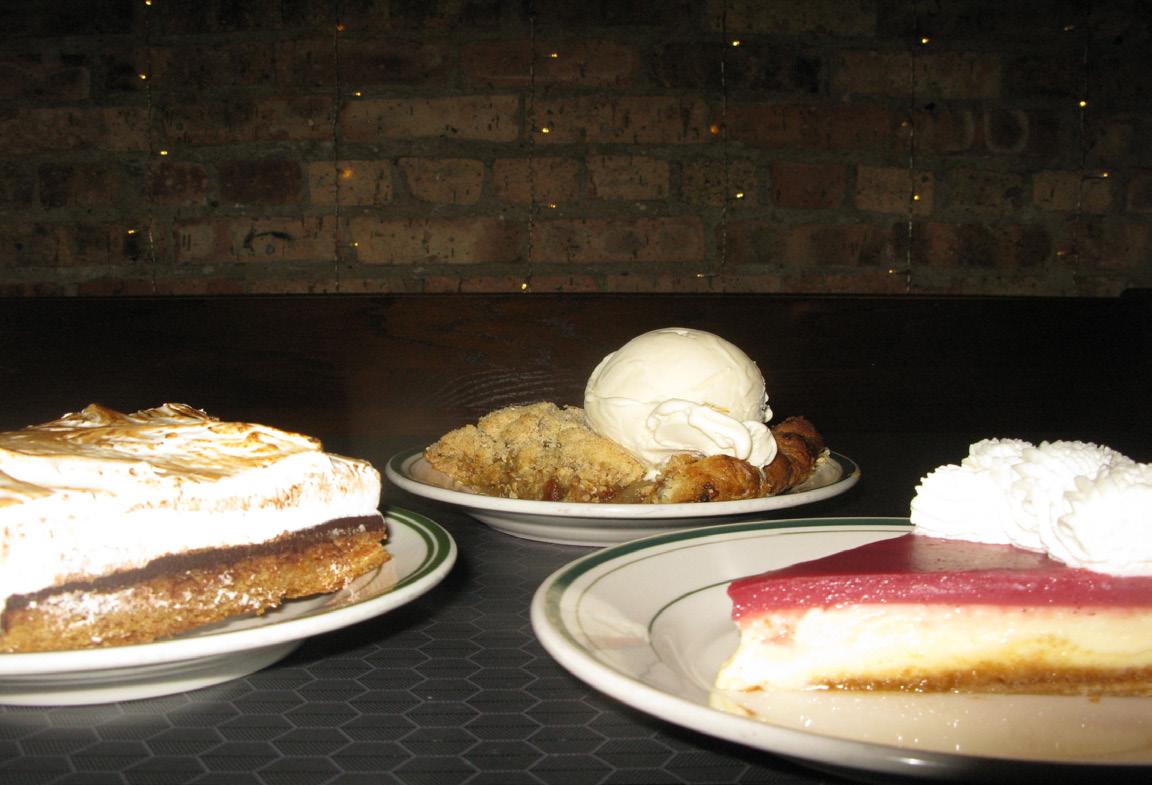

Recently, I have been in a dilemma. The “premier” and “innovative” restaurants marketed to us as the must-gos are nothing but trendy interiors and unremarkable food. I’m not talking about tasting menu joints that are genuinely breaking boundaries with taste; I’m thinking of those on Fulton Market’s “Restaurant Row,” that hit the top charts of popular food review sites but achieve more style than substance. We know the kind. How do I find genuine dining enjoyment in a food scene that prizes the image of a meal over its experience and quality?
When you enter Edgewater’s Beard & Belly, you don’t. You enter through the storefront of Honeypie Bakery, its partnering establishment, where you are greeted by a comfortable, friendly host behind a counter. The space has quirk: wallpaper I can only describe as grandma-esque (paisleys and all) covers three out of four walls, and there are not one but two unframed posters of the periodic table. Around the corner is a tavern-meets-sports-bar dining room. Metal ducts line the ceiling, and giant conical lights hang low. The centerpiece is a wooden bar with green leather upholstered chairs serviced by a bartender with a long ponytail and acid-washed t-shirt. Patrons laugh at wooden and metal tables, some inside and some out, the distinction blurred by the opened floor-to-ceiling doors on the east side. On the west sits a lofted dining space, perfect for gazing down upon the conviviality below. The vibe is refreshingly chilled out, with suggestions for a great meal ahead and markers of a space designed for R&R.
The space reflects their emphasis on the fun behind dining. In speaking with Beard & Belly’s owner Kyle Schrage, he shared: “We don’t wanna take ourselves too seriously, and we won’t want people to take us too seriously…It’s really easy to get trapped up into, you know, the chef world, where everything needs to be fancy.” But he and his co-owner Jim Torres are no burger-flipping Joe Schmoes. Both have been in the food industry for over a decade, serving years at high-brow restaurants. I asked Kyle if their laid-back approach was a response to previous experiences. He first swerved the question, then admitted that yes, it was partially in response to the suffocating seriousness of other restaurants he has worked at. Their efforts have not gone unnoticed, with Eater recently naming them the best Chicago can offer in “Cozy Comfort Food Restaurants for Winter.”1

1 Ashok Selvam, “Chicago’s Best Comfort Food Restaurants,” Eater Chicago, February 2, 2021, https://chicago.eater.com/ maps/best-comfort-food-chicago.
The menu promotes three things: BEERS, BURGERS, PIE. Along with the typical fried appetizers, they promote two signature burgers. The first is Kyle’s burger: “The Beard.” It is “robust, just like the man it’s named after,” with a half pound of beef, bacon, fried onions, tomato jam, and barbecue sauce. The second, created by Jim and known as “The Belly,” is “just like Chef…a bit spicy,” with Butterkäse (American cheese’s non-artificial cousin), roasted serrano, pickles, onion jam, & awesome sauce atop a smaller patty.2 I tried The Beard, and boy do they know how to make a good burger. The toppings weren’t overloading, rather working together: crunch from the onions, acidity from the sauce, sweetness from the jam. Nothing felt too greasy, especially in comparison to burgers I have tried in the past. And, above all, there was just something to it. This is probably due to the quality of each component, as Kyle explains: “That tomato jam takes hours to make…it’s one of those really simple ingredients [...] that we don’t even think about, but there’s a lot of work that goes into it.” That burger, though a humble vessel, carries hours of work and culinary skill, and it translates in every bite.

Like the food, the hospitality was rich: earnest suggestions were made, jokes cracked, and smiles glued on everyone’s faces. We finished with several desserts from Honeypie, my favorite being the seasonal cranberry pie, rounding out our meal with a tart, sweet note. As a restaurateur, in Kyle’s opinion, “you’re there to provide the best experience[...] Think about any restaurant that you’ve ever been to. If you have a good time, you’re gonna go back.” At the top of his mind is “a good time.” Not virality, not trend, but customer enjoyment. I fear that this is being lost today; going out to eat is an aesthetic, not a ritual of pleasure. Thankfully, Kyle and his partner are fighting against that.
With the slew of trendy restaurants in Chicago, eating at an establishment that prizes the customer’s enjoyment over its Instagrammability is refreshing. What Beard & Belly offers is actual vitality: genuinely friendly people, a comforting space, and damn good food. They are paving the way to a food culture everyone can appreciate, one mega-burger at a time.


2 “Beard & Belly,” Beard & Belly, 2014, https://www. beardandbellychicago.com.


How would you describe your food and restaurant to anyone unfamiliar?
Upscale American tavern food would be the best way I would describe our food. I don’t really like that cause it just doesn’t make it sound as good as it is. We do burgers, poutine, and cheese curds, but everything is done with a French background behind it, so we take all the extra steps. Our poutine gravy takes three days to make because we reduce it from stock. Everything we do has that quality to it. When you look at it, it is just a burger, so we’re not too fancy. But it is slightly elevated, rather than your regular bar food.
With your training, what led you to beer and burgers instead of other, perhaps less humble, types of food? So we first opened up inside the Long Room in Irving Park, and they have a little food window that they call a sidecar, and we were one of the first people to come into that area. The Long Room is like an old-school bar. It’s been around for 25 years. They wanted food that matched the bar, and I remember looking at Jim [Torres] when we opened, and I was like, hey if we decide to do burgers, we’re gonna be a burger restaurant forever. And he was like, well, I like making burgers, and if we make it a little nicer than what you normally get at your average place, we could both be happy with that. He gets to flex with our specials. We do a fancy New Year’s Eve dinner with fancier items. It’s a seated dinner and everything like that, of course, so we still get to do it, but the everyday food is burgers and poutine, as people we think enjoy and wanna eat regularly. Like, I can always have a burger, right?
Your website promotes Quality, Community, and Tomfoolery. Why do you take care to emphasize the fun behind dining?
Because it should be fun. We don’t want to take ourselves too seriously, and we don’t want people to take us too seriously, but we want to respect the quality of the food. The community is a huge part of it. We try to be a very inclusive community, so everybody is welcome here. It’s really easy to get trapped up into the chef world where everything needs to be fancy and everything like that, so we try and keep it kind of keep it simple and fun.
Is that in response to prior experiences of it not being so fun?
Yeah, I guess yes, would be the answer to that. In a lot of kitchens we’ve worked in in the past they get very serious and hotheaded. Everybody’s seen The Bear, right? Bits of that are true in some places. I’ve never worked in a kitchen that intense, but there are elements. I mean, when it all blows down, we’re just making hamburgers for people. I tell that to my staff too, when they’re serving tables and it gets busy, or it gets hectic, remember we’re just here to have a good time and make people happy and serve some quality food.
How did the name Beard and Belly come about?
I have a book that probably has about 40 different names in it, and we were just trying to pick. It’s weird naming a restaurant because it’s like naming a dog or a child, like, oh, this is gonna be my dog or my child for, you know, forever. We had a whole bunch of names, and Beard & Belly just fit. When we picked the name, I was like, well, I have the beard, and Jim was like, I know, I’m gonna be the belly (Kyle laughs). He fit that role pretty perfectly. It didn’t have any significance other than just how we look, and it’s catchy.
Where did you first start?
I started out with a Chicago hot dog stand in the mall. Then I got into restaurants and bars in college and kept learning more and doing more and I loved every aspect along the way. It’s not really the food and the drinks. It’s more about the people that are involved in the business. Taking care of somebody is a very good feeling. That’s kind of why I kept going forward with it. But the biggest thing for anybody would be to check it out. You can dip your toe in it and see if you like it, and if you don’t, you can always quit and go do something else, which a lot of people do.
Would you say your experience owning a restaurant changes the way you look at restaurants and participate in them as a customer?
When I go out to eat I like sitting near the service area. I like sitting where it’s busy. I like watching the restaurant happen. I love watching people work. I love having a bartender that takes care of you and knows how to kind of plan your evening out. When I was bartending and serving more, that’s what I tried to give people when they came out. That experience of having somebody that’s both attuned to what you’re looking for, but also knows when to back off or when to walk away. I care more about being able to see everything. I have a lot more leniency for when things are not going right at restaurants. Especially at places that just opened up, everybody’s getting their feet wet still, so there’s gonna be mistakes. There’s gonna be timing issues. Try it once in the beginning and if it’s not the best, then come back in six months and give it another try and see if they’ve been able to change, because like opening a restaurant is tough stuff.
Do you have any final thoughts for college students that will be reading?
Just go out. Just get out and experience. Open places up again. We just want people to come in the door and dine in. If you want places to stay in your neighborhood, you need to go to experience them otherwise they will shut their doors.
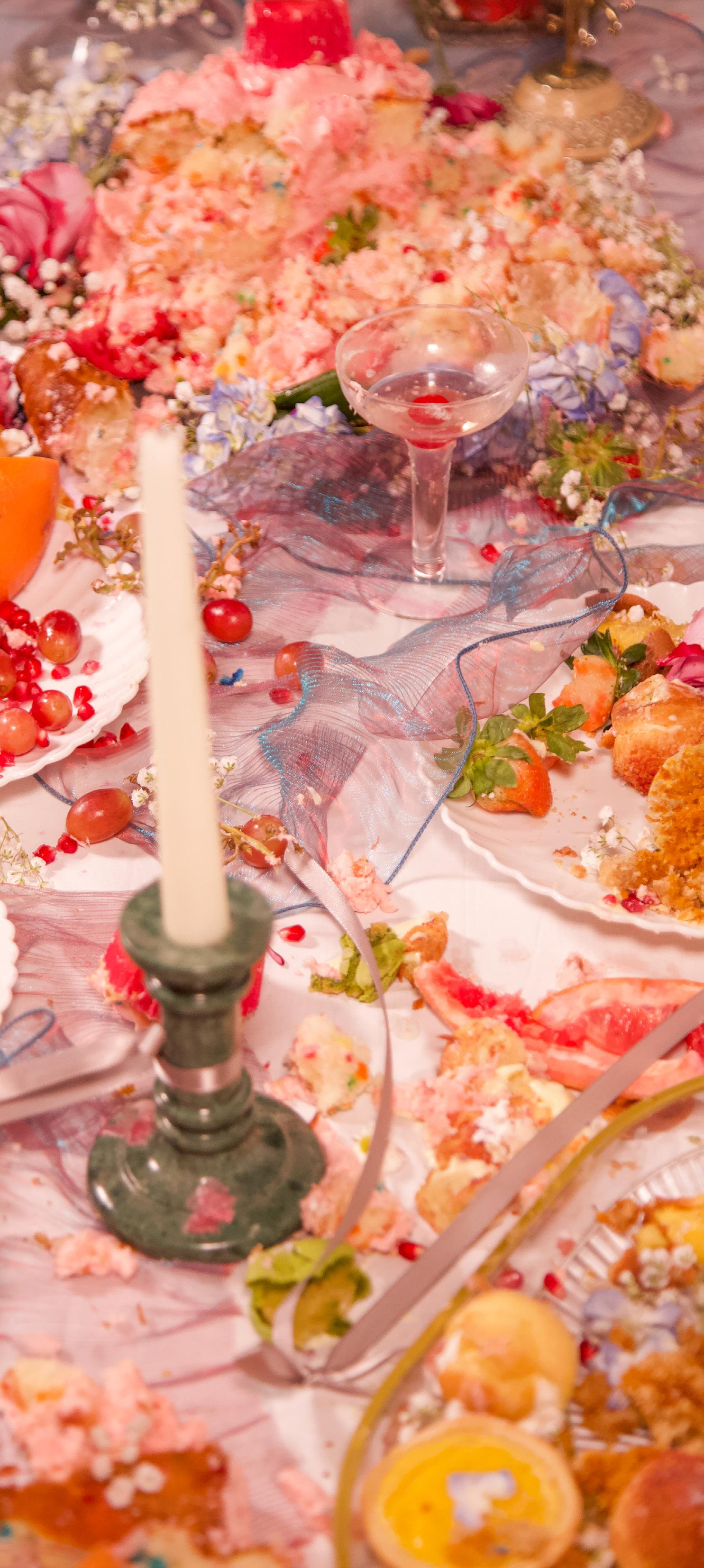

BY STACIA KONOW
TUMININU ONABANJO
What place does a paper magazine hold in the age of the short form video? In some ways, this magazine is archaic. It is expensive to produce, it takes up valuable space, it is not the result of an algorithm designed to capture your focus for hours. It asks for your full attention at a particular moment. To be enjoyed, this magazine needs to be held, to be passed around, to be opened, to be read, to be poured over. In the age of the short form video, it asks that you take your time, much like the food pictured in its pages. Many of these recipes and dishes are meant to be consumed slowly and savored, rather than devoured. You would not rush a dinner at Beard and Belly or wolf down chayote dumplings, letting them burn you rather than gently warm you up. Consumption has become a ratrace. Content is churned out every second of the day, and the image of something–rather than its inherent value–has become everything. So, what is the place for a food magazine?
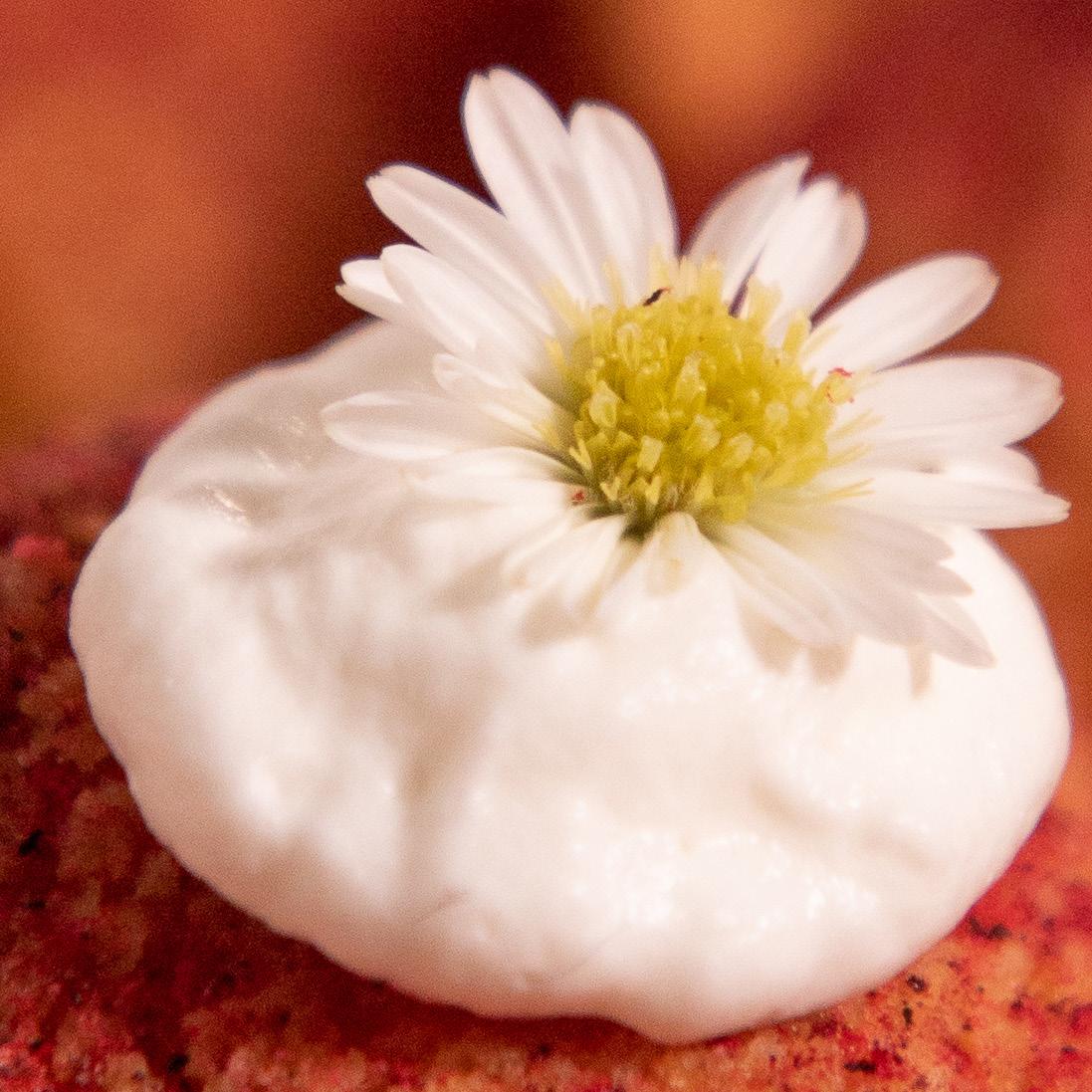
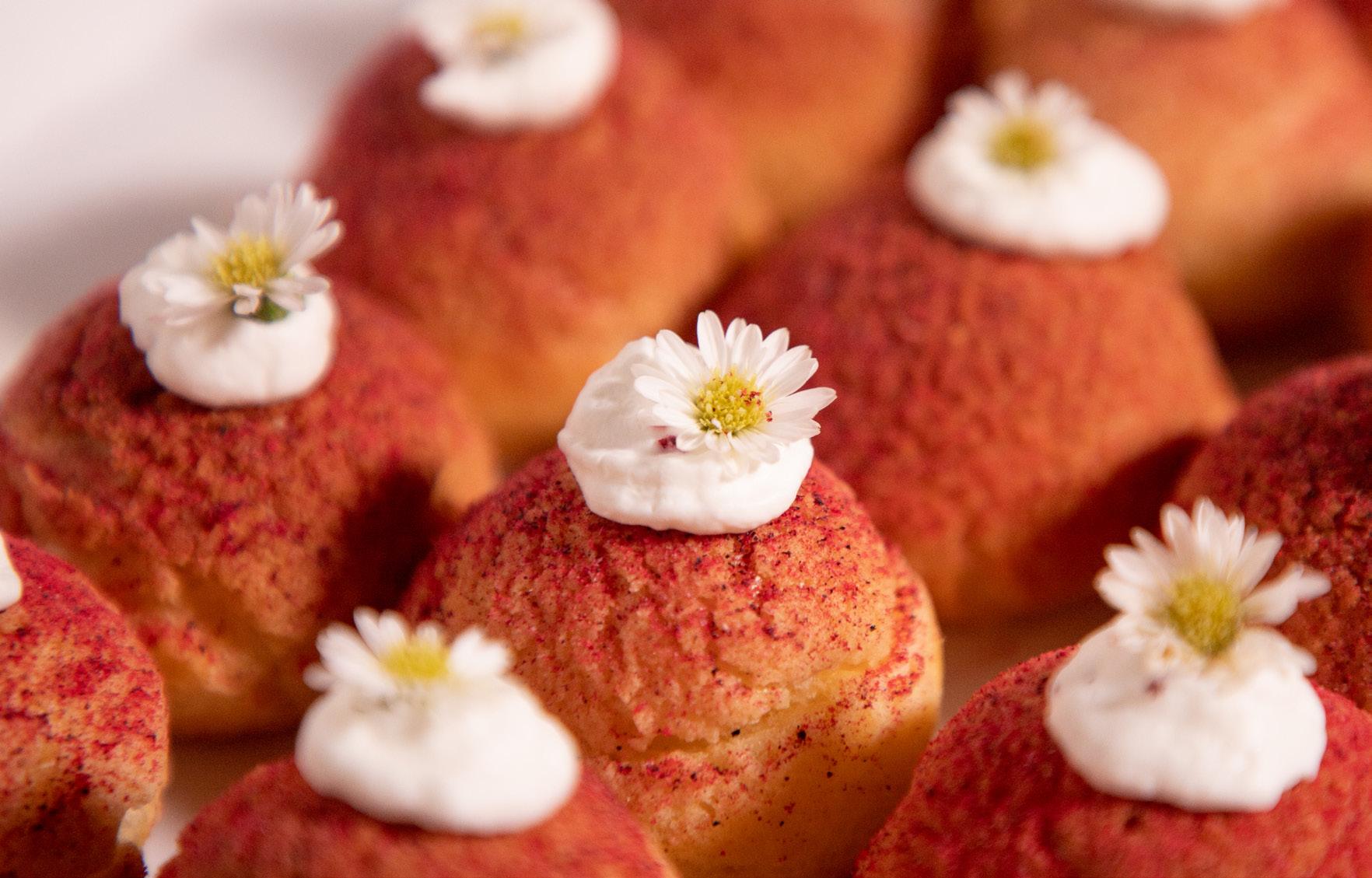
Consider the choices behind these words and photographs. The longer you look, the more you will notice. These cream puffs were made from scratch–filled with custard by hand, sprinkled with the dust of freeze-dried raspberries. The cake, however meticulously frosted, was made from a box. It was three layers of yellow Funfetti glued together with a mix of fresh buttercream and canned frosting and topped with maraschino cherries that could not even be dignified with a glass jar but instead came straight from a plastic container. Does that matter? The cake was devoured and destroyed in the same way that the cream puffs were. The candy pink frosting coated just as many fingers and lips as rosy dust. The coups were filled with almost intolerably tart cranberry juice instead of wine but at least the flowers and flames were real.

Things become fake the moment they are designed for your consumption rather than allowed to be themselves. Every advertisement for food or drinks incorporates some level of deception; whether that is just a bit of blanching and arranging of vegetables to make them look their freshest or using glue instead of milk in ads for cereal. The food in this photoshoot was primarily meant to be consumed visually by the readers of this magazine rather than for its taste, but I do not think that means the food or the photos are disingenuous. Professional chefs at any caliber have to think about how to present their food and their restaurants. If their food looks unappealing, no one will want to eat it–simple as that. To present foods in an unexpected and creative way tells its own story and enhances the experience of the meal. This is why 20 course meals work. The courses are fascinating and build off of each other, both in flavor and over time as you wait in anticipation for the chef’s next creation. Saying that the presentation of a dish is an art form may be taking it a step too far, however many similar considerations go into each process. As I watched the photographers work to capture the perfect shot of our creations, I was surprised to see them considering the same things I did when decorating the cake. I thought about color and texture and symmetry–all things they discussed as well.


satiating its consumer, but it becomes about appearances. As we learned with unicorn Frappuccinos and rainbow bagels, there is a limit to how far presentation carries a dish. When that mercurial line of flavor and appearance is crossed, all enjoyment in the experience is lost. Designing something for consumption–whether that is art or food–is a delicate balance of how it looks, how it feels, and what it inspires. All of this to say, take the time you need to savor something. If you like it, then the dish has succeeded. Enjoy.



Golden brown and delicately folded, fortune cookies are the perfect treat after a late-night Chinese meal, hiding a small slip of whimsy and lucky numbers within. Often thought of as a ubiquitous part of Panda Expresses and P.F Chang’s locations across the country, this small cookie carries a surprisingly layered history spanning hundreds of years.

A precursor of the fortune cookie can be found in Japanese literature from the late 1800s. 1 Called tsujiura senbei, the treat included sesame and miso. Made in Kyoto, they were often handed out at Shinto or Buddhist temples, paired with the omikuji, or random fortunes written on small strips of paper. Visit one of those temples today, and you’ll likely receive an omikuji yourself. Tsujiura senbei take the same iconic folded shape of the modern fortune cookie, but they are larger and slightly darker due to the miso paste. Instead of the fortune being neatly tucked inside, it is sandwiched between the two claws of the confection.



The tsujiura senbei came to the U.S. with Japanese immigrants in the late 1800s after the Chinese Exclusion Act halted Chinese immigration. Japanese bakeries on the West Coast, like the San Francisco Japanese Tea Garden, began selling “fortune tea cakes,” with designer Makoto Hagiwara claiming to have introduced them in the 1890s or 1900s. They claimed to be the first to use vanilla and butter instead of the usual sesame and miso. Soon, other businesses made similar claims, including David Jung’s Hong Kong Noodle Company and Fugetsu-do in LA’s Little Tokyo. The dispute reached the San Francisco Court of Historical Review, a mock court, where Hagiwara was declared the cookie’s inventor. 2 To make their arguments, the participants wore yellow makeup and “oriental” costumes, arguing their version of the fortune tea cake, all in pidgin English. At one point, the plaintiffs from San Francisco opened up a fortune cookie in the trial, which was read out as “S.F. Judge who rules for L.A. Not Very Smart Cookie.” Although the judge decided that Hagiwara was the original inventor, he stayed surprisingly neutral on the issue of whether it was Chinese or Japanese, stating, “matter of the east, we should leave to the east.”
1“Solving a Riddle Wrapped in a Mystery Inside a Cookie,” Jennifer Lee, New York Times, 2008
2 “The History of the Fortune Cookie,” Infoplease, 2020




On December 7, 1941, at 7:48 a.m., 353 Japanese aircraft attacked Pearl Harbor in Hawaii, shocking the U.S. into entering WWII. This attack started a campaign of xenophobia against Japanese-Americans, who were seen as secretly infiltrating the country on behalf of Japan. Soon, xenophobia, fear, and hatred reached their peak, and two months after Pearl Harbor, President Roosevelt authorized the mass internment of Japanese Americans. Over 110,000 people were forcibly relocated and incarcerated in camps across the West Coast. 3 Japanese businesses, including those making traditional fortune tea cakes, closed down. Chinese Americans seized the opportunity, adopting the machinery and renaming them “fortune cookies,” which were better suited for the American audience of the food.
As American GIs encountered these cookies in West Coast Chinese restaurants, they spread the idea nationwide, making fortune cookies a staple of Chinese-American cuisine. Who could have thought that the little treat from Kyoto could spread worldwide?
At first, this story seems like a simple case of confusing or lumping together certain Asian cultures. However, simplifying the story of fortune cookies only does a disservice to the Japanese Americans who pioneered the food. Japanese people lost claim to fortune cookies not through their actions but because they were forcefully relocated to concentration camps. Once a staple of Japanese culture, a disregard for the nuances between Asian cultures led fortune cookies to be associated with a completely different culture. And so, as I once again crack open the fortune cookie and eat the bland, slightly sweet wafer, I’m reminded that behind this unassuming treat lies a story of transculturation, cultural erasure, and appropriation.

3 “The Evacuated People: A Quantitative Study, Densho Digital Repository, 1946

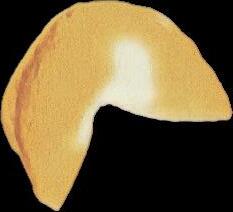



By Adam Zaidi










“Doubtless God could have made a better berry, but doubtless God never did”1
- William Butler



When I bite into a plump, sugary strawberry I think of childhood and sin. “That’s a lot of baggage!” I hear you exclaim, but the fruit has a mysticism to it which often gets obscured by its modern ubiquity. In his Garden of Earthly Delights, Hieronymus Bosch uses the fruit to symbolize temptation; however, it also appears in catholic paintings in the same period as a sign of virtue and perfection. This dichotomy can tell us at least one thing: it is a berry of ambrosiac delight. In fact, Markus Bockmuehl explains that “prior to the seventeenth century strawberries were not easily and widely cultivated [...] As late as 1680, the accounts for a London wedding dinner [...] suggest that a ‘dish of strabreys’ had cost six shillings, about six times a labourer’s daily wage”.2
Ever since the Ancient Persians first cultivated it3, the strawberry was a panacea. The Romans treated melancholy–an early diagnosis of depression–with it, while Henry VIII used its juice to heal his open ulcer, unsuccessfully. Despite its splendor, the fruit got its name from the earth: our modern name derives from the Old English “streawberige”, referencing the plant’s shoots strewn across the earth.4 In Swedish, the word for strawberry “jordgubbe” means “little lump on the earth.” In French, however, the noun has a much longer history.
916, Anvers. While on a state visit, the king of then-West Francia, Charles Le Simple, receives a gift of fresh woodland strawberries from the citizen Julius du Berry. Delighted, the king bestows upon du Berry the new name of “Fraise”– French for strawberry, derived directly from Latin fragum. The berries he ate were of the woodland variety. Native to Europe, they tasted sweeter, smelled more floral, and were much smaller than the modern berry.5
1368, Paris. In his sparkling new parisian palace, the Louvre, King Charles V orders 12,000 wild strawberry shrubs to be planted,enough to fill an entire flowerbed in the gardens. This means the royal court can feast on its darling berry more often and longer (for the entire month of June!) than in any other palace.6
1534, Golfe du Saint-Laurent. During his first trip to present-day Canada, French explorer Jacques Cartier discovers a new type of strawberry plant: the Virginia Strawberry. Accounts differ, but he undoubtedly came across the small, splotch-like fruits around the time he first made contact with the Mi'kmaq nation. He decides to bring a couple of these “scarlet strawberries” back to France, where he ends his journey on September 4th.7
1678, Versailles. King Louis XIV develops such a penchant for strawberries that he commissions his head gardener Jean-Baptiste de La Quintinie to build him a royal vegetable garden on an old swamp near the castle, previously known as the stinking pond. La Quintinie developed a series of greenhouse microclimates to grow fresh produce out of season, so that the king could eat strawberries starting in March! A court anecdote from the time stipulates Louis XIV ate so many strawberries that it made him terribly gassy, but refused to change his habit.
1 Compleat Angler, Third Edition (1661), Isaac Walton
2 Strawberries, the Food of Paradise: A Study in Christian Symbolism, Markus Bockmuehl













1714, Chile. Louis XIV sends an expedition headed by officer and engineer Amédée-François Frézier to offer military advice to the Spanish colonies in South America, but his real mission is to spy on the Spanish ports and fortifications in Chile and Peru. He presents himself to the Spanish as a traitor to the French throne, gathering intelligence on the colonies for his homeland; however, he finds more interest in a novel variety of strawberry native to the region introduced to him by the Picunche and Mapuche peoples of Chile. These “Blanches du Chili”, as he calls them, are much larger than any European strawberry and look whiter in coloring at the expense of sweetness and that floral taste so prized by Louis XIV. Frézier, a descendant of that original Julius du Berry dit Fraise, brings five plants with him on the journey back to France to present them to the king’s gardener. The strawberry starts to spread across France, but the berries never swell to the size they were in South America. Botanists all over the country puzzle over this problem afflicting the fruit so dear to their king.
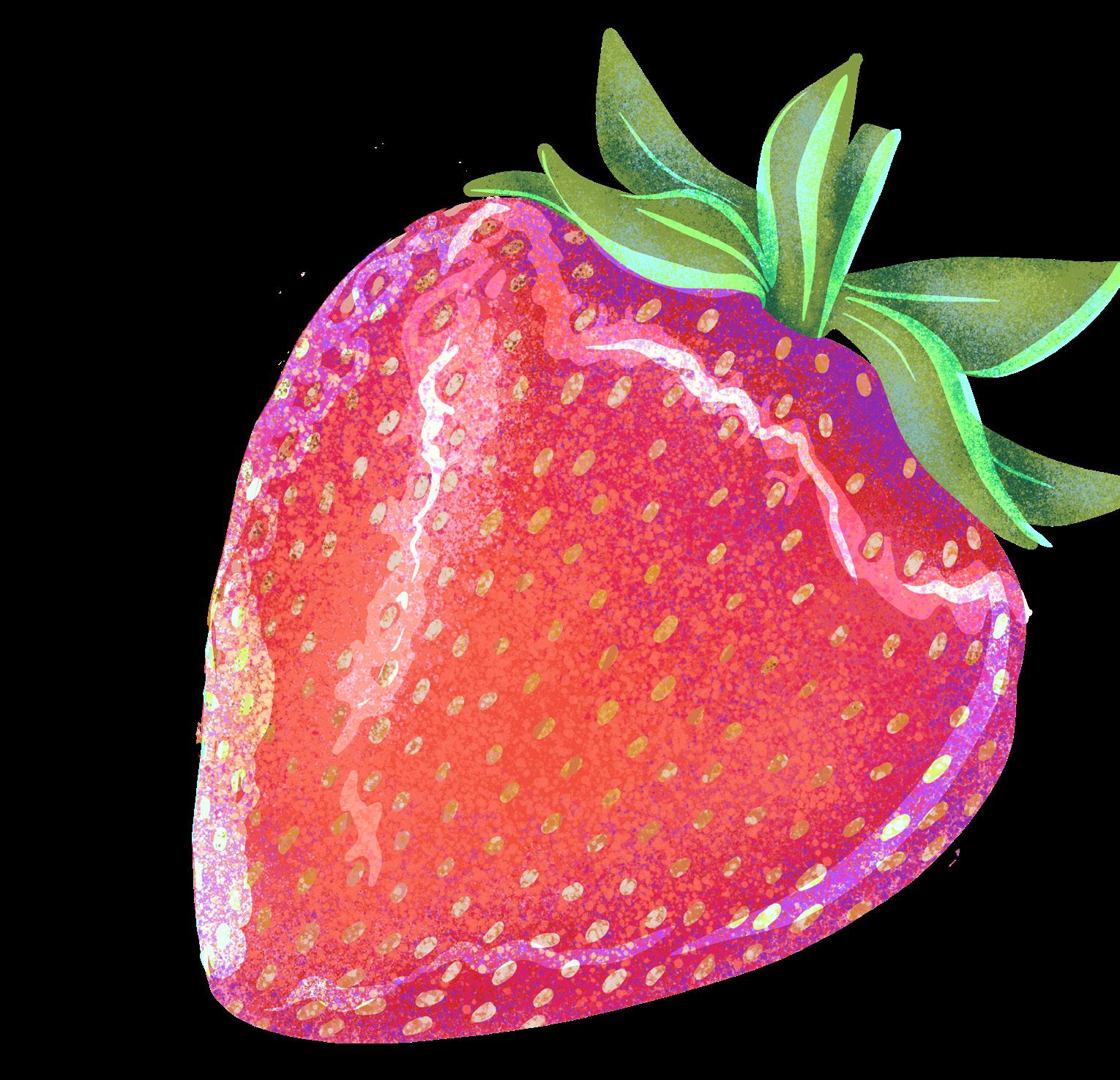



1740, Plougastel. Botanist Antoine Nicolas Duchesne solves the strawberry puzzle by noticing that Chilean strawberries reach their normal size when planted next to the now widely spread Virginian variety. Duchesne had finally understood that strawberries reproduce not only asexually, through cloning themselves, but also sexually through flowers. It turns out that Frézier had only brought female plants back to Europe since they were the ones with plump fruit! Duschene simply reintroduced male Virginean plants and watched the strawberry make itself. Thus, in Brittany, France, the modern garden strawberry is created from a cross of two American varieties. The first commercial cultivation started that year in a town called Plougastel which remains a primary center of French strawberry production to this day.
1867, Paris. Before the Great Exhibition (Exposition Universelle) of 1867, a prominent chef by the name of Auguste Escoffier decided to open his own restaurant. “Fraises Sarah Bernhardt”, a strawberries-and-cream based dessert inspired by the famous actress, features on the dessert menu, quickly gaining notoriety.8 Later in his career, Escoffier worked as head chef for César Ritz, who gave his name to the luxury hotels. He inspired Gaston Lenôtre’s invention of the Fraisier in 1966, a traditional french strawberry cake with alternating layers of buttercream, fresh strawberries, genoise cake, and simple syrup.

2024, Chicago. After coming to know them so intimately, I can never look at a strawberry the same again. The amount of time, money, and labor poured into the creation of this fruit is dizzying– and all for a simple berry! Manifestly humanity’s intrinsic drive to eat good, interesting food transcends continental barriers, for it is a truth universally acknowledged that a person of taste must be in want of a berry to brighten their day.
3 Interesting Strawberry Facts, Garden Museum website
4 Monthly Etymology Gleanings for March 2015 (Oxford University Press Blog), Anatoly Liberman
5 How Strawberries were Accidentally Invented (video), Tasting History with Max Miller
6 Histoire de la Fraise, Cellier de Revigny website
7 Histoire de la Fraise, Burban Producteur website
8 Histoire des Fraises Sarah Bernhardt, Blog de la BnF Gallica website



Writer: Jacqueline Oury
Illustrator: Ana Estupinan
Written By Chris Wong
Designed by Emma Tung
Illustrated by Emily Son
I did not know that Buddhist practice could be anything other than meditation, reciting scriptures, and dharma talks.

In the basement of the American Wisdom Association in Billerica, MA, I carefully lifted my knife away from a plump red tomato. Its delicate meat was serrated in half and diced to uniform chunks, while its translucent juices stained the blade’s chrome edge. At that moment, nothing mattered to me more than cutting that tomato correctly, and all the thoughts in my mind faded in the face of this important moment. On this Saturday morning, I was volunteering to cook for the celebration of Guan Yin Bodhisattva’s birthday. Hunched over a prep table, I could hear the chanting from a hall of worshippers radiating through the basement floorboards, the frenzy of lay-chefs clanking pots against stoves clamored behind me, and the dull thud of my knife against the wooden chopping board kept the rhythm of this new dharmic melody. I felt no different then than I did a few weeks prior while reciting scripture at the very same temple. In that moment, I could feel the rising sense of stillness, and despite only knowing the dharma practiced upstairs—the conventional Buddhist teachings of chanting and meditation—I knew somehow that my way of practicing Buddhism belongs in a kitchen.
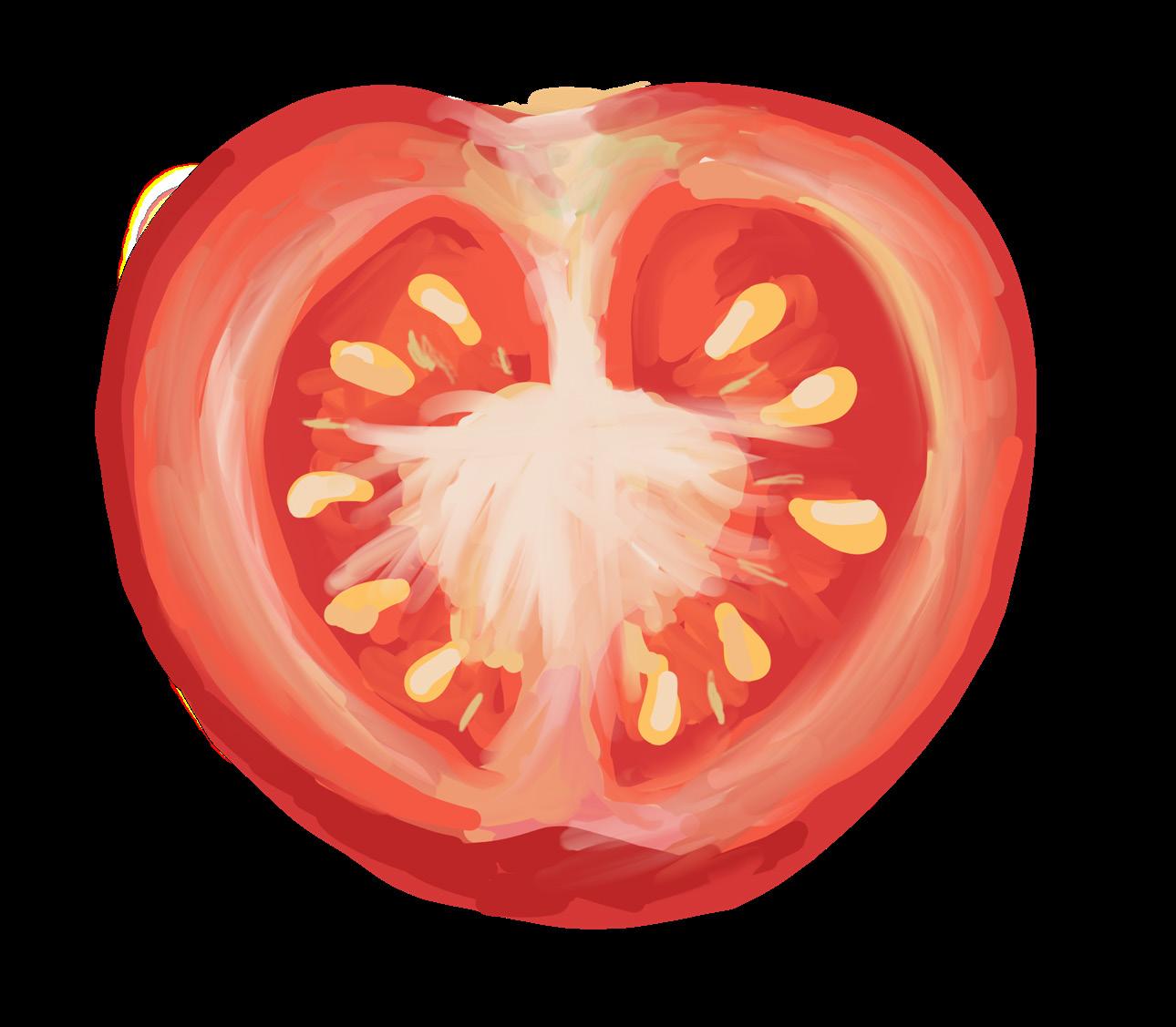
In the Japanese Zen tradition of Buddhism, there is a strict form of vegetarian cooking called Shōjin ryōri. The words quite literally mean “zeal in progressing along the path to salvation.” Chefs practicing the Shōjin ryōri tradition go through years of training before even being allowed to use a knife; this process develops a reverence in the chefs for the vegetables themselves. As the Zen master Dōgen Zenji once said in his Instructions to Tenzo, a cook should “handle even a single leaf of green in such a way that it manifests the body of the Buddha...This in turn allows the Buddha to manifest through the leaf.” Shōjin ryōri embodies the practice of Zen Buddhism, where within the great rigor that it takes to make vegetables into a culinary artform practitioners find a space of stillness and wisdom.
I can not say that my amateurish cooking can be classified as Shōjin, but I can feel that the specific action of cooking helps me become more centered in what I am doing. Then, I asked myself: even if it is not Shōjin, is this a Buddhist practice? I reflected on how the journey of finding the perfect state of mind was more accessible to me though cooking than meditation and saw how the conditions of my life had led me to this preferred means of practicing Buddhism.

I grew up in a family of adventurous Chinese eaters and chefs, so I acquired an insatiable appetite and a respect for food. I used to work side by side with my mother, helping her dice garlic, scrub off vegetables, devein shrimps, and everything in between. This upbringing made it easier to see that chopping vegetables was not just a chore but instead an action that warrants my full presence. The same can be said of any other task. In fact, master Sheng Yen of the Chan Buddhist tradition once said in a lecture that the best ways to practice dharma is what is most immediately present to us. For me, this was being in a basement, chopping vegetables. The smooth gliding motion of a blade’s cold steel edge against my buckled fingers constantly draws my senses to the cutting board. As I gently lift the knife and place it down, I become aware of how the muscles in my wrist and fore-arm flex against its weight. With each stroke, my meditative subjects—vegetables—release aromatic surprises and delightful juices, which reminds my senses of the task at hand. These sensations closely mimic how I practice breathing meditations: following my breath, carefully attending to the pressures of my body, and letting go of thoughts that demand my attention.
I now see that the conventional practices that I do—meditating, dharma talks, chanting—can help support how I approach practicing Buddhism in the rest of my life. While I was trying to chase the Buddhist practices that seem normative, like meditation, I forgot the practices that I am more attuned to, or did not even realize could be centering. Meditation is hard for most, and it is certainly hard for me, but chopping vegetables is easy and something I do almost every day. This is my meditation. Eventually, the Buddha teaches that all dharmic paths lead to the same place, so why should I take the long way there when I can practice dharma in the kitchen instead?

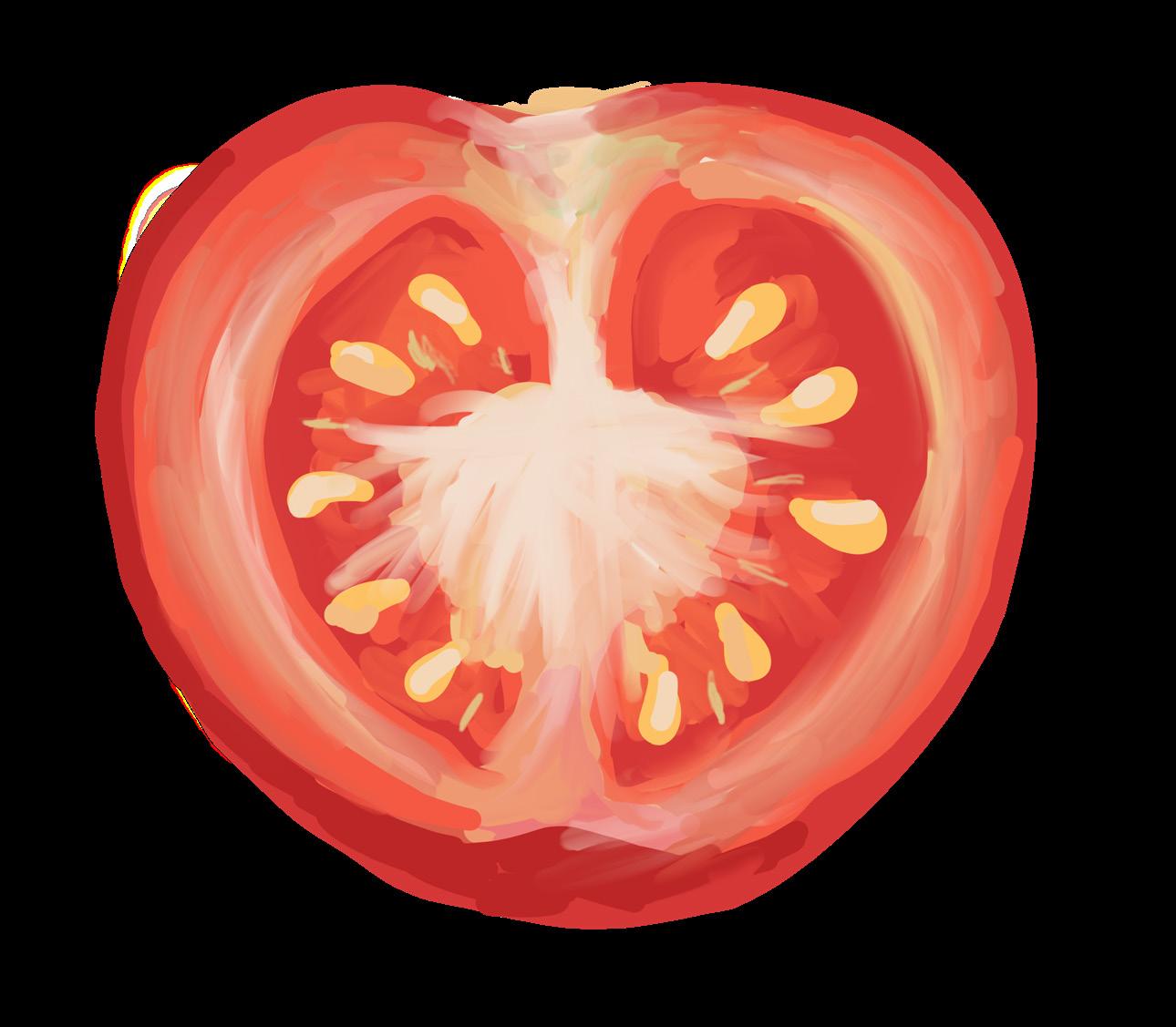


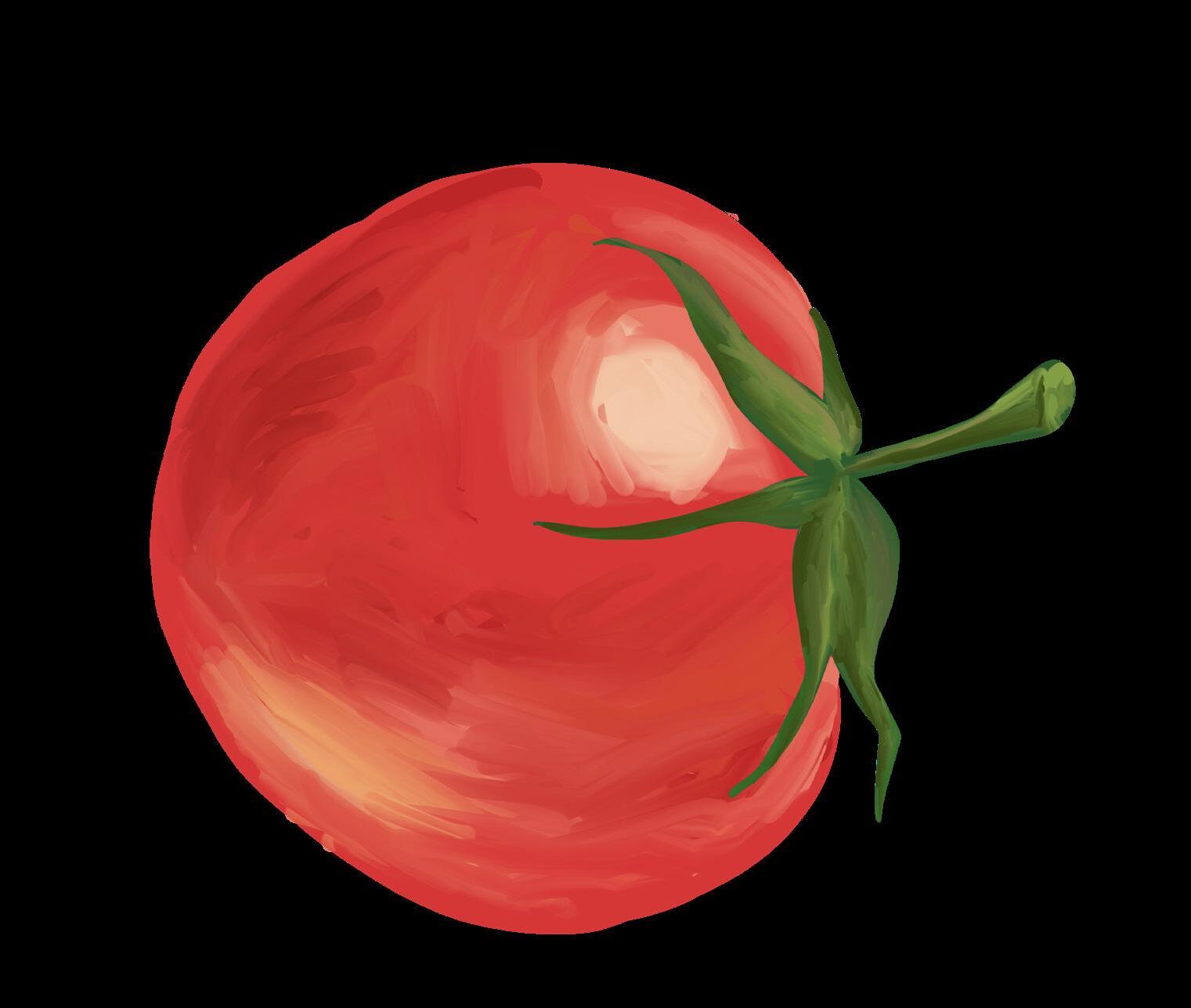

I’m here to bring you an inside look that goes further than influencer accounts of the paddock club – I want to show you an inside look at an actual Formula 1 team’s hospitality experience – MoneyGram Haas F1, not a meal paid for by a Paddock Club ticket that can cost upwards of $10,000. Aside from the incredible race day experience, the hospitality operations were impressive. I shared my meals with the hardworking individuals, who smoothly operate a team with many moving parts on a global stage, but the team motorhome created an intimate setting. The hospitality team is tasked with feeding almost everyone on the team, so they make smart menu choices for dishes that are scalable yet refined, and use clean ingredients to keep everyone on the team in peak physical health. The hospitality team is a well-oiled machine, able to execute this mission precisely to give sponsors and guests the perfect trackside experience. Inside the motorhome itself, everything from the walls to the dishes to the sugar packets for espressos are branded with team logos. However, there are also elements of community that provide comfort to the race team members who travel frequently. For example, no twoperson tables exist, so everyone dines with company. Indeed, having access to delicious and quality meals is another way to maintain comfort for people away from home as they support a race team.
Written by Olivia Shanler
Designed by Diana Gothong
In recent years, Formula 1 has skyrocketed in popularity in the United States. Previously, most Americans focused their motorsport interest on domestic circuits like NASCAR and IndyCar. Now, it’s an exciting time for Formula 1 in America. Withdocu-series chronicling on-track drama, flashy sponsorships, and influencers documenting the exclusive “paddock experience,” Formula 1 has become a fast-growing sport that brings intrigue, culture, heritage, and excitement. Part of this intrigue is due to the rarity of the trackside experience. Many Formula 1 fans will never see a live race, as there are only 20 races a year, leading to shockingly expensive tickets. As such, accounts of the most exclusive experience, the paddock “club,” full of celebrity sightings, hot brand pop-ups, and prime hospitality experiences, are primarily brought to light by influencers. These accounts showcase decadent all-you-can-eat caviar, Cedric Grolet pastries, topshelf cocktails, prime steak and seafood, and more. However there is more to the story. I was pleasantly surprised by my trackside culinary experience in regards to how different it was from what I’d seen on social media.
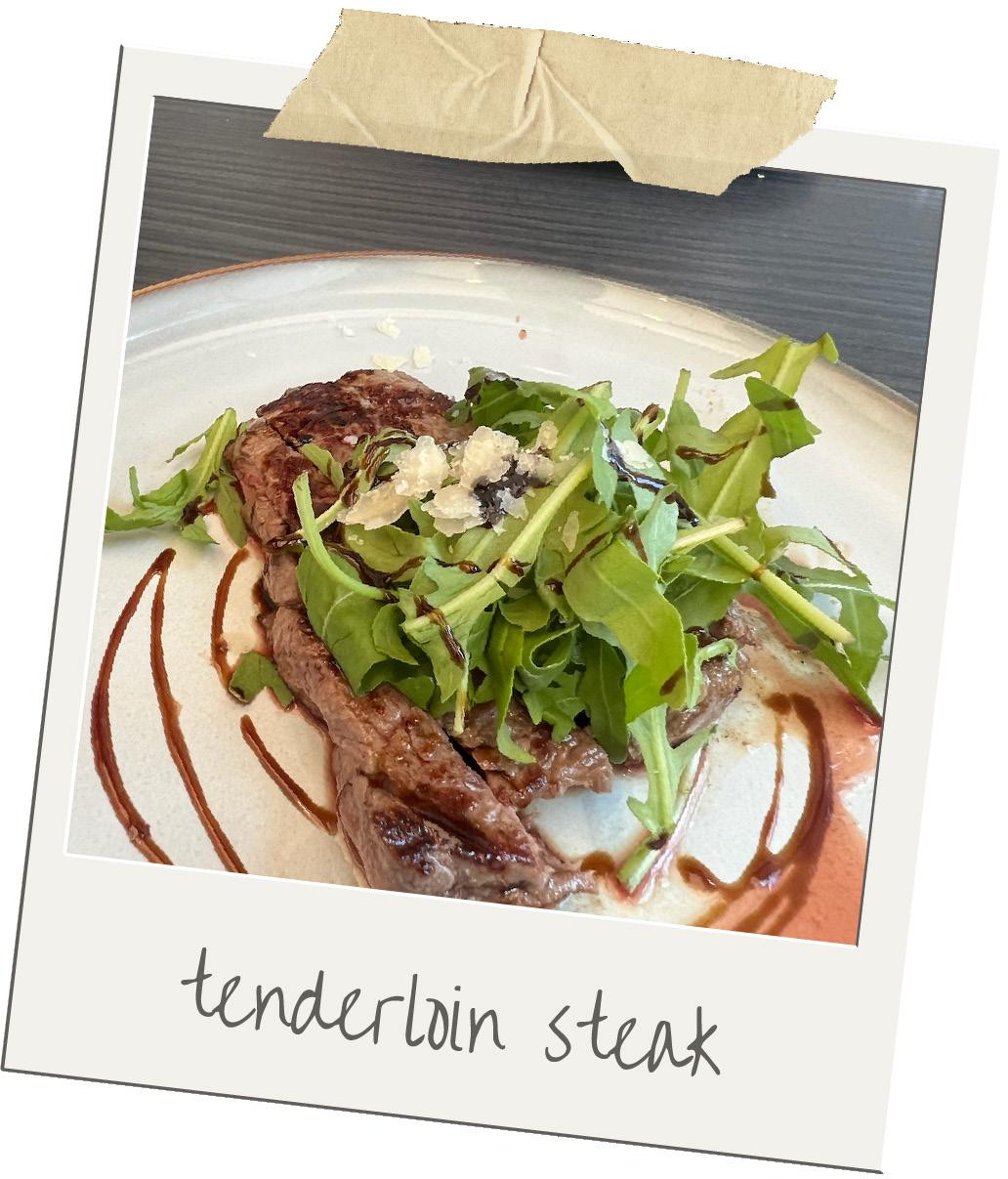

As stated before, the menu at the team motorhome needs to be suitable for athletes, executives, sponsors, and guests. Everything is intentional, chic, and uses healthy and clean techniques to create meals that are equally delicious and nutritious. Nothing on the menu is fried, greasy, or sugary, although treats are scattered throughout the motorhome for guests and team members requiring a chocolate fix. I began my meal with a cappuccino, which was amusingly branded with the team “H” logo using cocoa powder. I also enjoyed a glass of Taittinger Brut with my meal, another brand supporting the Formula 1 grid.
For a starter, I had cured sea bass with tomato and cucumber. As a delightfully refreshing beginning to my meal, the light soy cure on the fish balanced nicely with the cucumber and acidity of the tomato. On a hot summer race day, this hit the spot. Next, I had a grilled tenderloin steak tagliata with arugula and parmesan. The steak was cooked perfectly, and the dish as a whole was very satisfying, savory, and not too salty. I also enjoyed grilled octopus with a celeriac cream. I was fully expecting the octopus to be overcooked and rubbery but was pleasantly surprised – it was succulent and charred beautifully. The celeriac cream offset the smokiness of the dish and paired nicely. Finally, we had Eton mess for dessert, a classic British dessert with meringue, cream, and berry compote. This was a lovely nod to England’s heritage in Formula 1 and a perfect way to end the meal, as it wasn’t too heavy, so I had plenty of energy for trackside adventures later in the day. You simply can’t go wrong with an Eton mess, and it was a great use of summer ingredients too, with the mixed berry compote pairing well with the light meringue and cream.
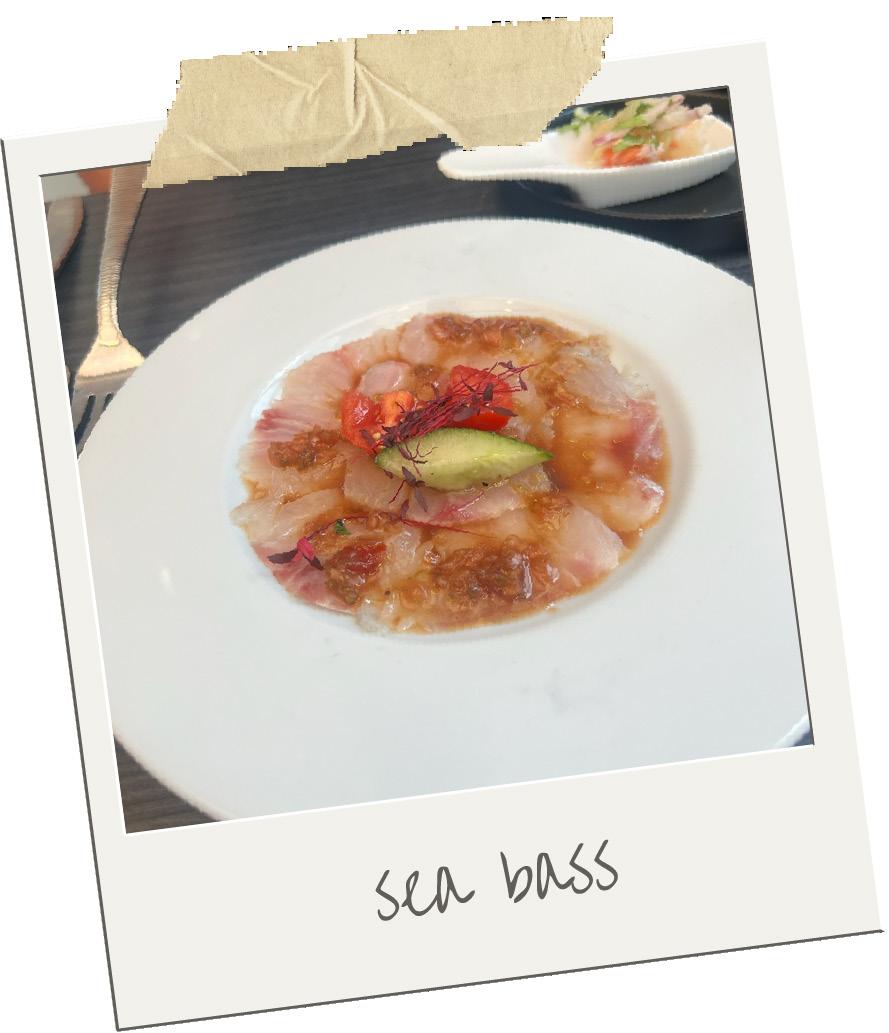
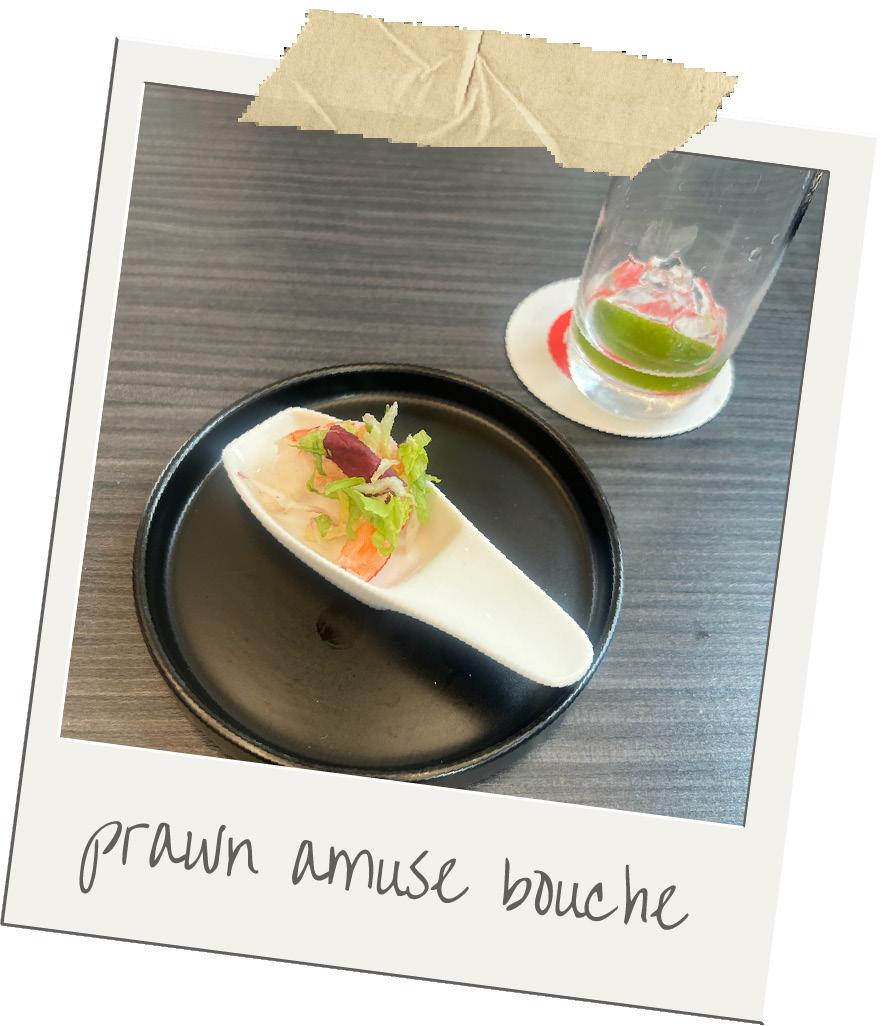

Overall, the menu I sampled was simple, delicious, and light, yet every element was executed perfectly. I admit, I was not expecting the food to be as beautifully plated, designed, and prepared as it was. As an American, perhaps I was letting my judgments be influenced by American sports foods, like wings, hot dogs,and burgers, all delicious but different from what I enjoyed at the team motorhome. This difference comes from a cultural place, as there are not many Americans involved in Formula 1. Also, the team hospitality department is responsible for looking after athletes and sponsors, not just fans. Everything in Formula 1 is close to the pinnacle of luxury because of the involvement of heritage racing brands and sponsors. It is impressive that racing teams can execute the level of hospitality that I experienced regularly, and appreciated too. It is important to keep people fed and happy, be they sponsors or athletes themselves. Additionally, experiences like the one I had define the fan experience. For all the excitement of fast cars, charismatic drivers, exciting locations, and more, the unsung hero of Formula 1 is, in my opinion, the trackside hospitality – this is truly a key element of creating a family within a team.
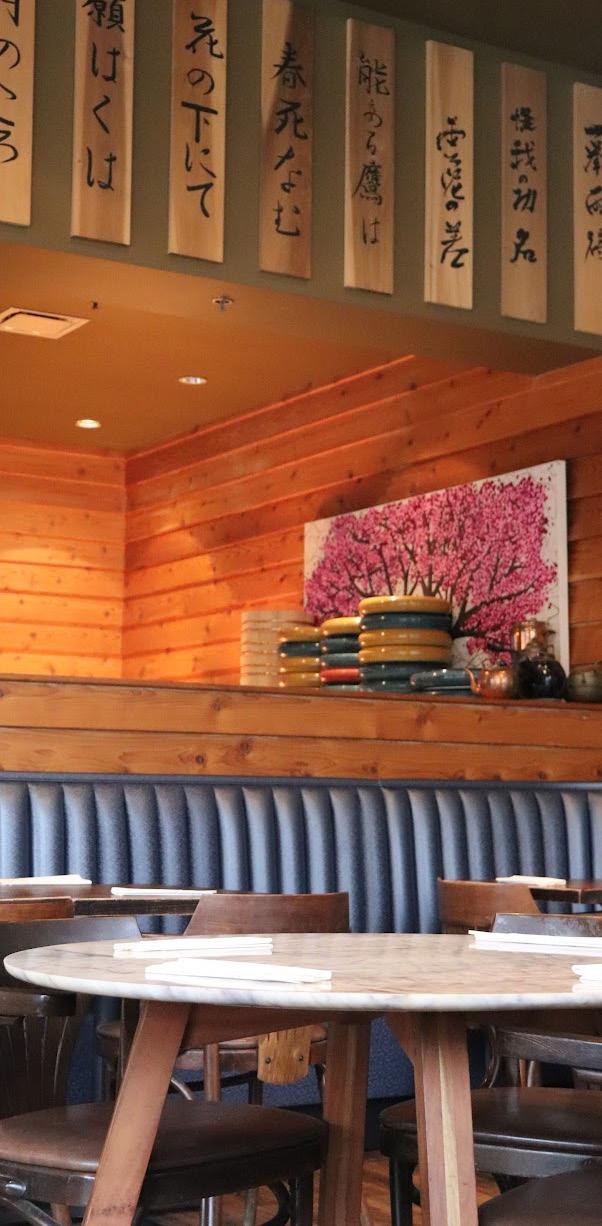
>> NEIGHBORHOOD
LOGAN SQUARE
>> PRICES
$-$$
>> THE PLACE TO TRY UMAI
BY CHARLOTTE ENGRAV & KY CRUZ DESIGNED BY EMIILY SON
When I sit down to try a new Japanese restaurant, the comfort dish I search for on the menu is always Japanese Curry. Most likely brought to Japan from India by the British Empire around 1850[CE1], curry powder made its way into Japanese cuisine, sometimes prepared with vegetables and served over rice, as a brothy base for udon noodles, or contained within a fried bun. Restaurants around the world specialize in the dish, but none are based in Chicago. Eager to dig out the best takes on the dish in Chicago, we set off on a crawl:
[CE1] Curry — it’s more ‘Japanese’ than you think | The Japan Times

Morikawa Bento (Avondale, $) is the Chicago location of a Hong Kong-based chain of bento restaurants, which serve bento boxes (single-serving meals comprised of many different smaller elements, oftentimes a main protein served with rice, a vegetable side, and sometimes fruit). They specialize in takeout, so we ate togo, and ordered the Chicken Katsu Curry bento. One section of the bento was filled with curry made of corn, potato, and small bites of carrots. The other contained a bed of rice piled high with wellbrowned, flavorful chicken katsu (panko breadcrumb-coated chicken cutlet), which traveled exceptionally well. The last, smaller section was heaped with pickled vegetables, which cut through the heavy curry and rice. While the take-out model is not the most effective in preserving the ultra-satisfying, steaming, cozy effects of the dish, all technical elements of the dish were pulled off exceptionally. The rice was cooked perfectly, well-seasoned with furikake (seasoning made up of finely chopped seaweed, sesame seeds, sugar, salt, and msg), and the katsu was delicious all on its own, the chicken being especially well-seasoned. The curry was good too, its high concentration of vegetables satisfying and lightening the sauce. If you’re ordering in on a cold winter evening, Morkiawa would be an excellent pick.

Kyuramen (River North, $$) is another global chain, its interior boasting a row of stacked honeycomb booths off to the side, which customers have to wait in a separate line to dine in. We ordered Katsu Omurice and selected the curry sauce to be poured over. The Instagram-famous omurice (a wet-cooked Japanese omelet enveloping a bed of ketchup-flavored fried rice) gets dressed in a flashy tableside service, the pork tonkatsu sitting on a separate plate atop a bed of lettuce. The dish is rich and indulgent, balancing the textures of soft fried rice with runny scrambled egg and runnier – slightly spiced –curry sauce. The side portion of tonkatsu is genius, keeping its crisp breading from going soggy underneath the sauce. The meal is a good choice for Japanese curry if you’re craving some in the area in a pinch, but the curry itself is executed better elsewhere.

Umai (Loop, $$) is a well-loved neighborhood spot, its cozy interior a comfortable place for a quiet lunch or dinner, or to watch a football or basketball game on one of their many large televisions behind the sushi counter. They boast an extensive menu hitting sushi, ramen, udon, and donburi, including their Katsu Kare, which we ordered with an onsen egg (a slow-cooked, silky smooth egg, similar to poached in texture). Their serving is the most curry-centric, arriving in a bowl sitting on a bed of rice, with an option of chicken or pork katsu out over the top, a neat garnish of fukujinzuke (red pickled vegetables) adding a pop of color and flavor to the bites. Their curry is simple yet fragrant, with no vegetables for texture but well executed nonetheless, paired with a katsu that is fresh and crisp. The portion is huge, so after putting some work into the plate, the pieces of katsu that remain might run soggy.
All three spots we visited offered different interpretations of Japanese curry, so all stand out in their own ways. Morikawa’s was portable and tasty, but their takeaway system takes away from enjoying the curry at its freshest . Kyuramen’s is picture perfect but might neglect hitting all of the best flavor and texture points in the process. Umai’s is satisfying, rich, and cozy. If you could only hit up one of the three spots, Umai would be our recommendation.
>> NEIGHBORHOOD
HYDE PARK
>> PRICES $$
>> DISHES TO TRY
JERK CHICKEN WINGS
REGGAE SALMON SLIDERS
COCONUT SHRIMP
CHEESECAKE FLIGHT COCKTAILS
BY AIDAN CESSOR
PHOTOS BY KENNEDY JONES
ILLUSTRATIONS BY EMILY SON
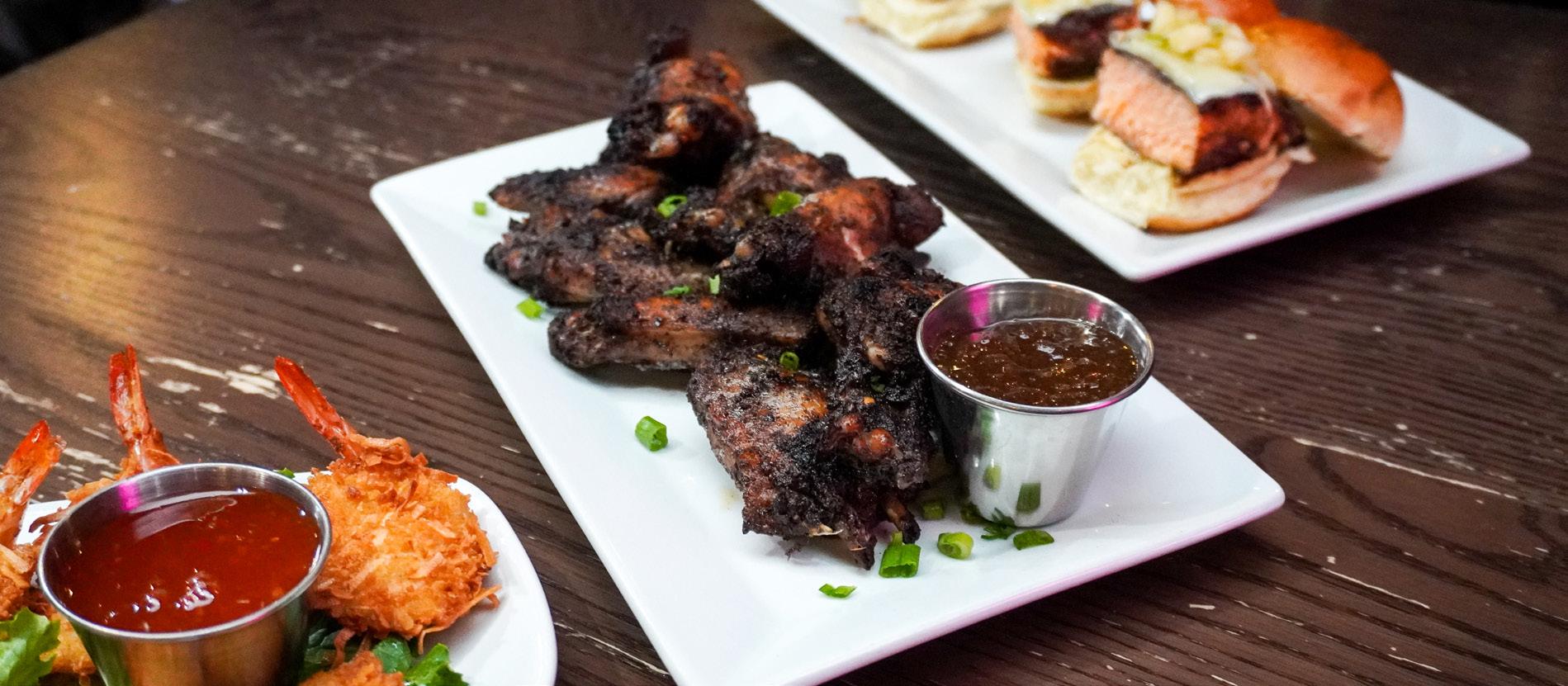
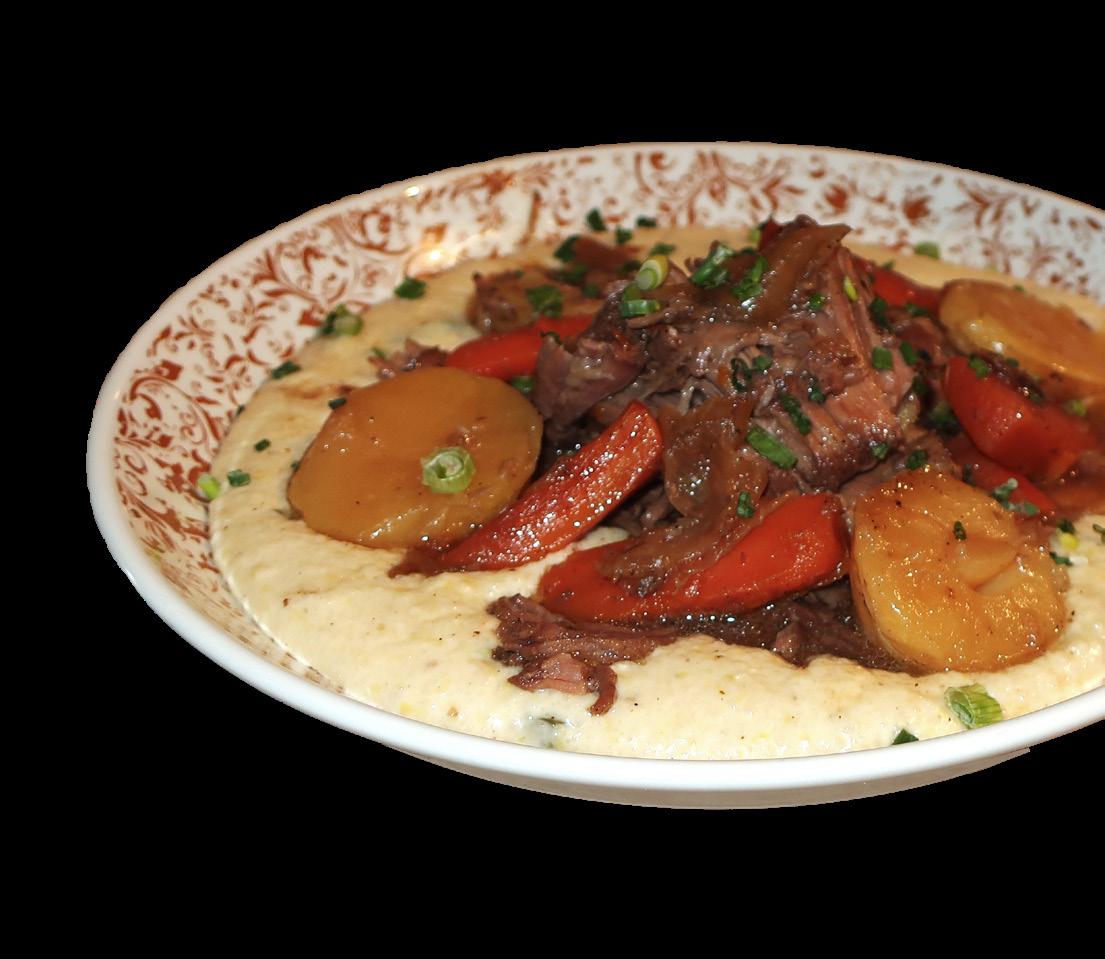
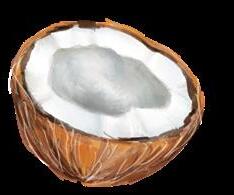
“Put the Lime in the Coconut,” these pink neon words radiate into 14 Parish’s dining room. This Hyde Park Restaurant and Rhum Bar is located on 53rd Street, just a hop away from the lake. Known for its Caribbean fare and extensive rhum collection (the added h is the French spelling), 14 Parish is a place to relax after work. With the wood paneling as dark as the molasses rum is made from, 14 Parish invites you to feast on all its jerkspiced dishes.
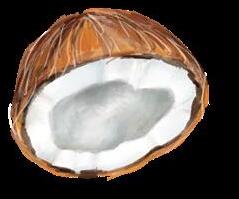

During my experience at 14 Parish, the appetizers stood above the rest of the menu. Such is the case with the Coconut Shrimp, which has always been a favorite but is often too heavily breaded and scant on the coconut. 14 Parish did not step into this pitfall. Bursting with coconut flavor, the crisp and light breading makes for a succinct snap. Moving onto the Reggae Salmon Sliders, tender and moist fish were paired with melted white cheese, a peculiar pairing that was pleasantly surprising. With three sliders to an order, this is a unique shareable dish. Finally, the best appetizer out of all the Jerk Chicken Wings. Covered in the smoky jerk rub, the wings were tender and spiced from the skin to the flesh, paired with a jerk sauce bursting with even more flavor. While not overbearingly spicy, the wings tickled my tongue and encouraged me to sip on my cocktail.
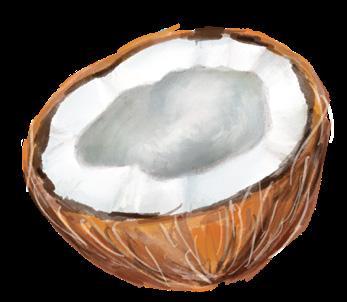

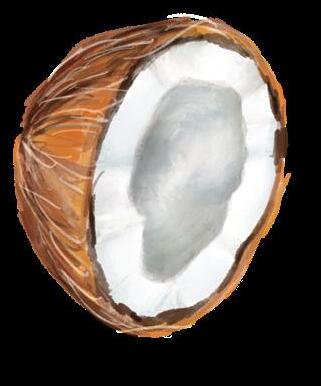

At the heart of 14 Parish is the rum. With over 150 different bottles behind the bar, 14 Parish takes pride in having at least one rum from every rum-producing country. Since rum is the first American spirit, 14 Parish tries to incorporate every group of people whose history is tied to the spirit. Ironically, the two cocktails the Director of Beverages recommended did not contain rum. The Halfway Tree consisted of Brazilian Cachaça, condensed milk, carrot juice, and mace. Creamy with a subtle vegetal aftertaste, this cocktail pairs well with spice-laden dishes, providing a soothing sensation to those who can’t handle the heat. The second cocktail I tried was the Mayaro that combined tequila, mezcal, St. Germain, Campari, guava, and lime into a fruity drink with a smoky undertone from the mezcal. The cocktails and spirits are the focal point of 14 Parish and should not be missed during your visit.

In conversation with the Director of Beverages, Jeffery, he gave a deeper insight into the philosophy of 14 Parish. Named after the 14 Parishes of Jamaica, the restaurant wishes to pay its respects to the enslaved Africans made to work the sugarcane plantations that fueled rum’s history. By highlighting the region’s food and drink culture, 14 Parish honors the suffering of the enslaved people and the displacement of Indigenous Caribbean people. Overall, I enjoyed my time at 14 Parish, which does a great job bringing all the history and flavor of the Caribbean into Hyde Park.

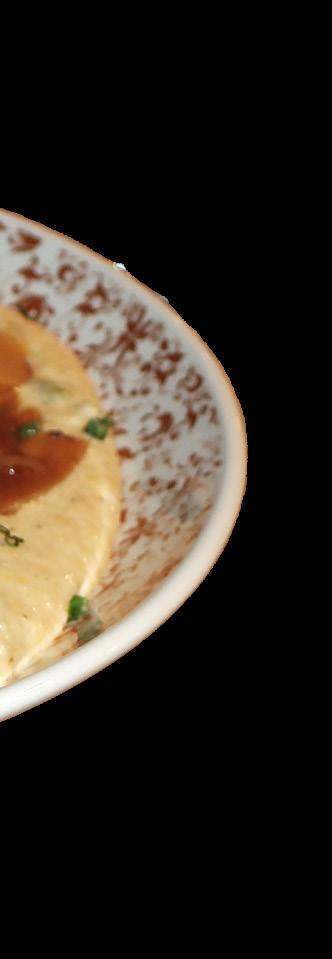
>> NEIGHBORHOOD HYDE PARK
>> PRICES $$
>> DISHES TO TRY POT ROAST WITH JALAPENO GRITS BISCUITS WITH LEMON-POPPY SEED BUTTER
Built into the base of a regal brick apartment building, Dawn is the perfect spot to enjoy a southern-inspired meal. With an all-day menu from breakfast to dinner, patrons can choose what they desire: a hearty meal, buttery biscuits, fried catfish, or sweet breakfast delights. The fresh, bright blue paint makes even the darkest winter days warm, while the white marble countertops give the homey fare a new level of sophistication.
Starting with southern classics, the biscuits were one of the stars in this food constellation. Browned on the outside yet pillowy inside, these were obviously handcrafted with love. Accompanied by lemon poppy butter and hot honey, the biscuits become a vehicle for rich and spicy goodness. Another wonderful appetizer was the Fried Green Tomatoes. The breading was thin and crispy, with the green tomatoes revealing their juicy tang with every bite. The remoulade alongside it didn’t overpower the subtle flavor of the breading but rather gave it more depth. These two starters were an excellent beginning to
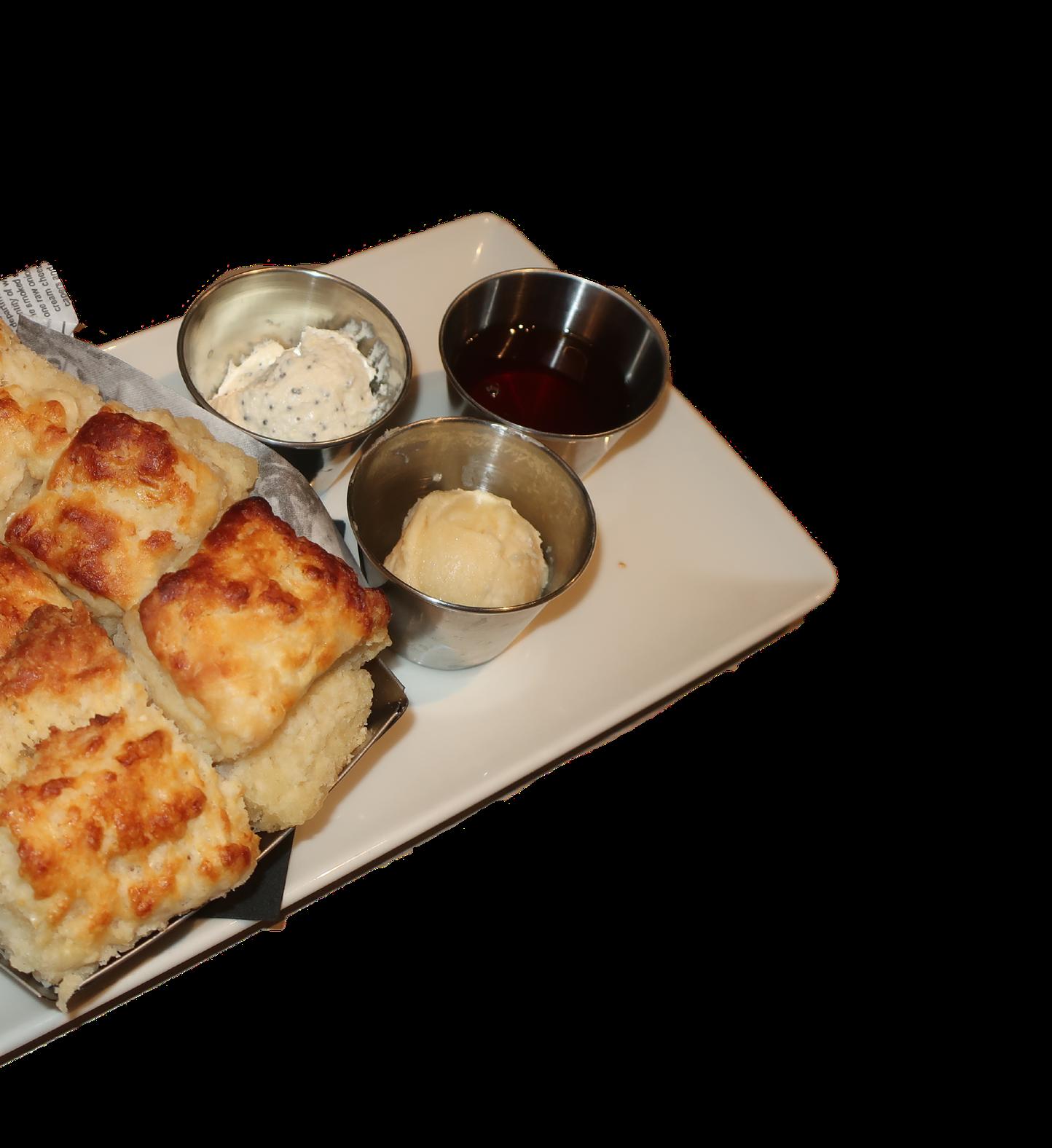
As CEO of Color Hospitality, the group that owns and runs both Dawn and 14 Parish, Racquel Fields is a force of her own. Starting in the kitchen of an assisted living home, she now has two restaurants to call her own and wishes to expand further into the wider Chicago area. The group's slogan is “There’s a color for your palette,” represented through its restaurant's vast offerings. 14 Parish is a Caribbean restaurant specializing in rhum, making it a great social hub. Dawn’s elevated Southern cuisine is an excellent spot to grab dinner or drinks with friends, while the take-
The centerpiece of the experience was the Pot Roast with Jalapeno Grits. Easily filling four starving stomachs, the meat was forktender, marking the hours-long cooking. My favorite piece of this dish was the grits. Creamy, hearty, and a hint of heat, the dish was satisfying, warm, homey, yet new. richness made it nearly impossible to eat dessert— of course, I did anyway.
Ending on a sweet note, the Mississpi Rhum Bar delivered on its promise of being a chocolate lover's sin. With layers of brownie, chocolate sponge, and ganache, topped with a praline made from a 100-year-old family recipe, I felt I needed to head to confession.
Speaking with Kathleen Frantz, she gave me an insight into the history and ethos of Dawn. Pairing her southern upbringing and extensive resume in the culinary arts, Kathleen gives her family recipes an elevation. Every pastry is made from scratch in-house every morning. In her words, “Good food is coming back,” with culinary skill and care resurfacing as virtues of a good restaurant. She hopes that Dawn becomes another community hub like 14 Parish, with ideas like bringing high tea to the South Side marking the progress toward that goal.
out portion is convenient for busy students. Dawn also partners with the student-run cafes to provide tasty pastries on campus.
When asked about a single piece of restaurant advice, she said, “Don’t let the Universe say no. Always keep trying.” And that she did, because the day Dawn was supposed to open its doors, the City of Chicago shut down the entire city due to the COVID-19 pandemic. With her team, she powered through by doing take-out only and emerged stronger with the wish to uplift the Hyde Park community.





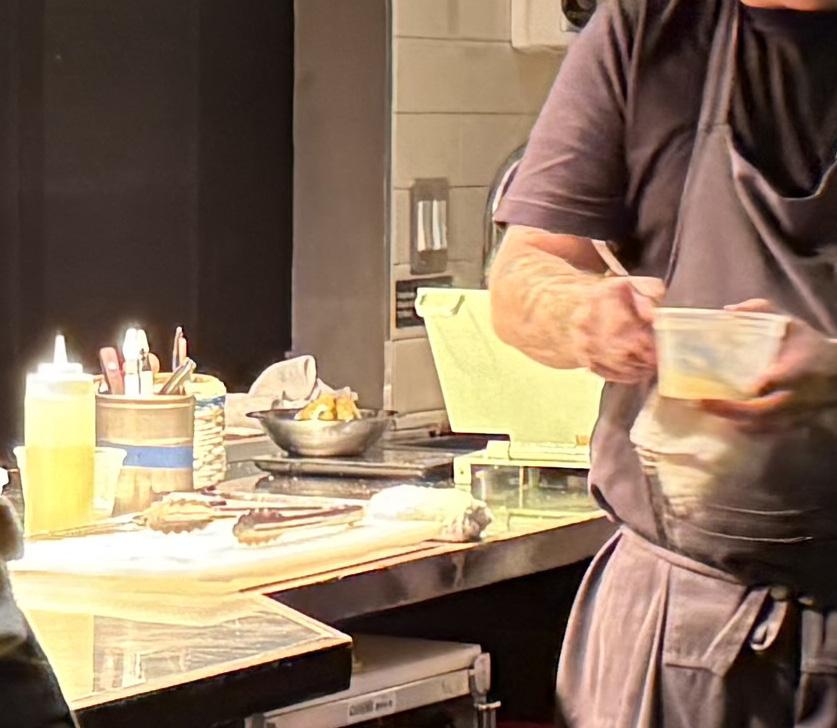
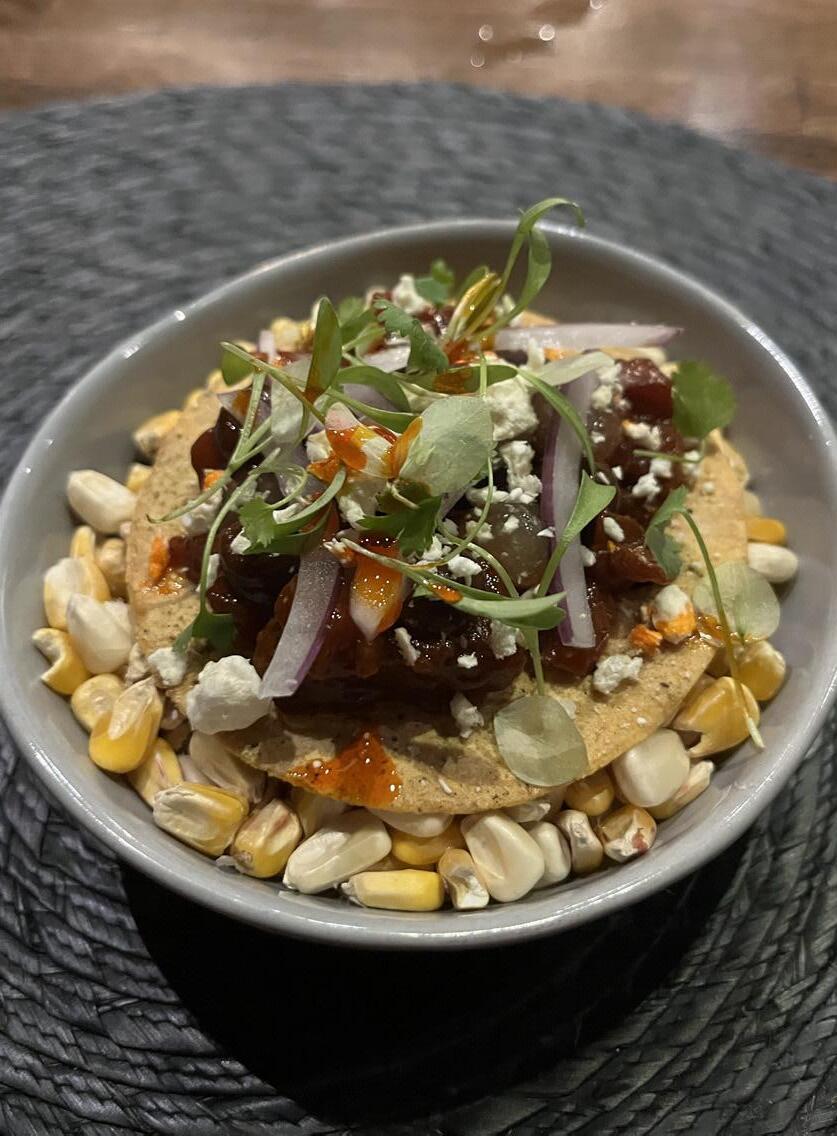
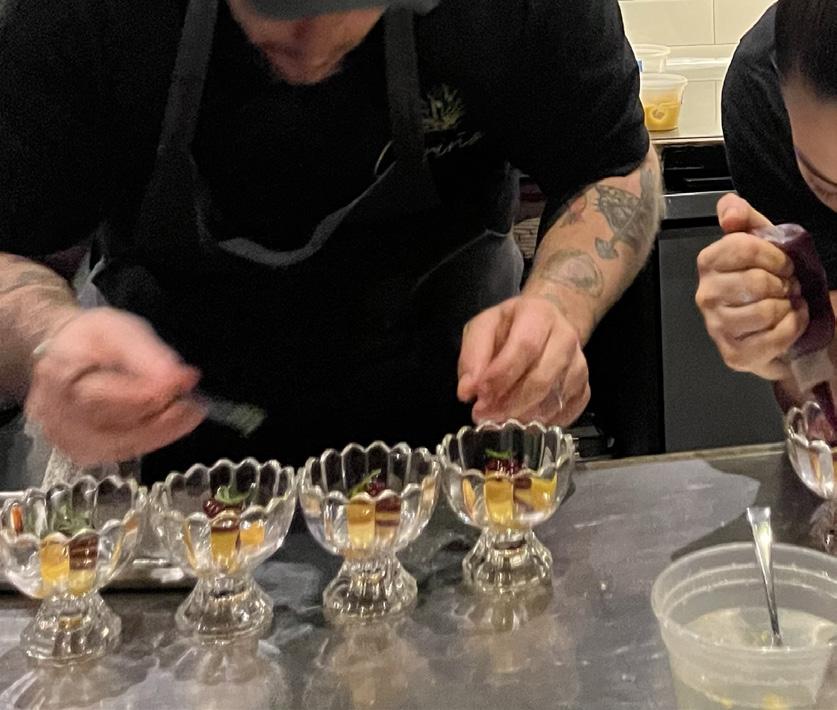

Cariño is Chef Norman Fenton’s newest fine-dining venture in Chicago. It occupies the same space as his last restaurant, Brass Heart, that shuttered in June last year. Fenton previously worked at Michelin-starred Schwa in Wicker Park. Cariño offers a 12-14 course tasting menu that has received rave reviews online and in the Chicago Tribune. Time Out Magazine described it as possibly the “best dining experience in Chicago right now.” I went for the late night Taco Omakase offering – the more affordable 8-course counterpart which seats you at the chef’s counter for an upclose view – I was unwilling to shell out nearly three dollars for the full tasting menu experience.

The space is inviting, if a bit austere. The kitchen is the centerpiece of the small room, bright and warmly lit, while the counter and table seating are in relative comfortable darkness. A carefully positioned Lionel Messi Funko Pop figure overlooks the counter alongside pristine copies of the Noma and Lula Café cookbooks and Rick Martinez’s famous Mi Cocina cookbook. Fenton clearly wants to communicate his influences, but he tries not to come on too strong. He was, for the most part, talkative and relaxed in the kitchen, cracking gluttonous jokes about smoking weed and eating hot dogs.
The first few bites were creative and delicious. First was an oyster michelada, a play on the traditional Mexican drink. Fenton combined the briny oyster with a Modelo beer foam and Clamato pearls, resulting in a bracing, spicy opening bite.
BY MAX BROENING
PHOTOS BY AUTHOR

went on. The bluefin tuna tartare tostada was the worst offender–a too-salty bite that tasted mostly of barbecue sauce. Following was a series of several tacos, one with duck breast, one with pieces of beef belly, and finally, one with A5 wagyu. While good, the tacos relied too much on the flavor of the meat, which was sometimes a bit tough or chewy.
The meal finished strong with dessert, though – a mango sorbet topped with a sauce made from chile de árbol. I had not tried a spicy dessert before and appreciated the surprising contrast with the sweet mango that made for a complex finish to the meal.

For all his airs of a laid-back hedonist, Chef Fenton was an exacting force in the kitchen. Perhaps tensions were higher than usual–there was a film crew recording footage for an episode of an as-yet unnamed television show–but his hushed admonishments to his staff were perfectly audible to our front-row seats. This made for a slightly awkward experience at times, but maybe it is just part of the transparency afforded by dining at the counter.

Cariño was just honored as Chicago’s newest Michelin-starred restaurant, earning one star in the December 2024 update to Chicago’s Michelin Guide. The refinement that one expects with a Michelin star was visible in some dishes, but the tacos seemed to fall short–perhaps there is a ceiling on the quality of a taco. The insight I gained from such a close view of the kitchen was interesting, but felt a bit voyeuristic. Maybe I prefer a more private dining experience and a bit more mystery surrounding the food. >>
Next up was an aguachile – a dish somewhat similar to ceviche made with a watermelon radish gel and thin slices of raw salmon fillet. The flavors were bright and spicy and the presentation was impressive; it came out over a bed of dry ice that billowed cold fog.

However, the flavors became less precise and lost their spice as the meal

>> NEIGHBORHOOD THE LOOP
>> PRICES
>> DISHES TO TRY
POTATO PANCAKES WITH APPLESAUCE & SOUR CREAM
@SCHNITZEL HOUSE
PIZZA-STUFFED PRETZEL @STUFFED GOURMET PRETZELS
ALMOND-APRICOT STRUDEL
@HELMUT’S ORIGINAL AUSTRIAN STRUDEL
TIMTOM SNOWBALLS @GERMAN GRILL
CURRYWURST & LENTIL SOUP & POTATO SOUP
@GERMAN BROTHERS
AMARETTO CANDIED CASHEWS AND RUM CANDIED PECANS
@SWEET SWABIAN
BELGIAN HOT CHOCOLATE
@BOB’S BELGIAN HOT CHOCOLATE

While the trek to Christkindlmarket in a Chicago December requires tremendous layering and bravery against the bitter cold, there is no other place where I feel quite so warm. Since 1996, Chicago's Christkindlmarket, currently located at the Daley Plaza, has been recognized as one of the best Christmas markets in the world and was enjoyed by more than two million people (at multiple locations) in 2023.1
There is something so charming about participating in this shared Chicagoan tradition. The people at the market are almost as
BY SAMMY ALDERDEN PHOTOS BY KENNEDY JONES
favorites. Year after year, I revisit my favorite: Helmut's Original Austrian Strudel. The strudel is served warm. The puff pastry is exactly how puff pastry should be: flaky, buttery, messy. My order, the almond-apricot strudel, is stuffed with a sweet almond paste and a tart, gooey apricot filling. I look forward to this treat all year. Persuaded once again by my sweet tooth, I typically also visit the nearby German grill for their TimTom snowballs, a buttery, dense donut with a crunchy exterior and a Nutella topping.
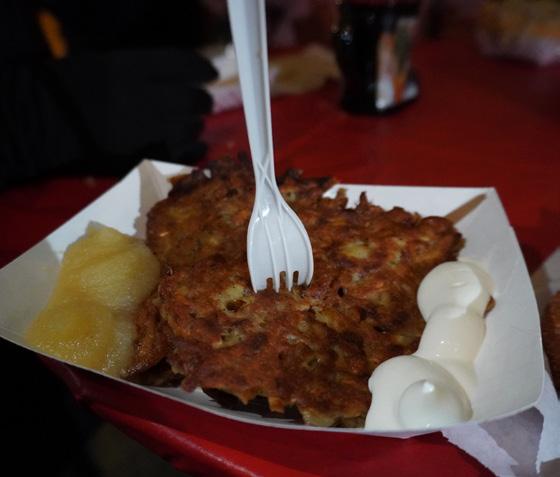
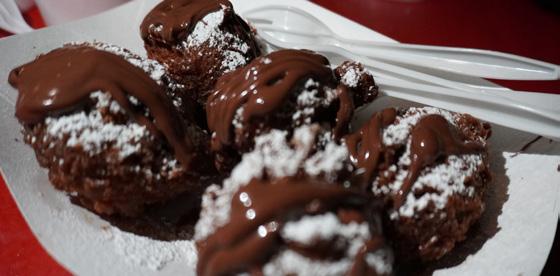
important as the foods, smells, or music: whether that is the couple you share a standing table with who asks you, "Where did you get that?" or the friendly man at the hot chocolate stand who gives you an extra gingerbread cookie. Everyone at Christkindl is there for a good time, making the cold bearable with these wholesome interactions.
Of course, nothing at Christkindl warms you up from the inside more than the food. Christkindlmarket is consistent: year after year, you find the same vendors in the same spot, which makes it easy to revisit
However, when visiting Christkindl, it cannot be just for dessert. On the savory front, German Brothers is my go-to. Their currywurst, bratwurst slices in a curried ketchup sauce, is warm, sweet, and earthy. My favorite part about German Brothers, however, is that they serve soup, a necessity in the freezing weather. Their lentil soup is deliciously hearty, always served piping hot, with slight notes of lemon. The lentils offer texture to the soup, contrasting with the equally good pureed potato soup also sold there, which has a peppery, warm flavor. You also cannot go to Christkindlmarket without trying a potato pancake: fried disks of grated potato, topped with the seemingly odd yet weirdly perfect combination of light, sweet apple sauce and dense sour cream. Not all potato pancakes are created equal, and Schnitzel House, in my opinion, takes the cake - or rather, pancake. On your walk back to the metra, or in my case, to your Uber if you lost track of time and
missed the train, you need a piece of Christkindl's warmth for the ride home. I am a hot chocolate snob, but I can definitively say that Bob's Belgian Hot Chocolate is worth the extra money. It has a bold, semi-sweet chocolate flavor and is topped with homemade whipped cream and a gingerbread cookie. If you want to collect the iconic boot mug, Bob's is the place to go.


>> NEIGHBORHOOD PILSEN
>> PRICES
$$ REVIEW
>> DISHES TO TRY
TUNA TOSTADA
SHRIMP GOBERNADOR TACO
I first found out about Mariscos San Pedro from a ranking titled “Top 5 New Chicago Restaurants 2024” on the Beli app. Located in Pilsen next to Thalia Hall, this new establishment has caused a lot of buzz amongst local restaurant-goers for its fresh and flavorful seafood options that artfully combine Mexican cuisine with quality sea-fare. The restaurant itself offers a hip and newly-renovated ambience, yet was quite understated in its external presentation, making me skeptical of how exciting the experience could be. We visited during brunch time and were able to take advantage of the coffee menu by ordering a latte—not a typical seafood pairing but a welcomed accompaniment nonetheless. As for the real appeal of the restaurant, the food options, we ordered a favorite on the menu, the tuna tostada, as well as the shrimp gobernador and plantain tacos.
First to arrive for the food was the tuna tostada, called a “complex flavor explosion” by The Infatuation1 and one of the restaurant’s most popular dishes. Naturally, I had to see for myself what all the hype was about this seafood experiment. The first thing you see is a pop of beautiful reddish pink from the raw tuna, evidence that they prioritize quality, fresh fish. This mound of vibrant fish was peppered with the greens, reds, and yellows of various toppings that, at first, gave me the impression of too much going for such a unitary item, endangering the tostada’s overall flavor. After trying, though, I have to agree with The Infatuation on this one, as nothing really could have prepared me for the sophisticated yet wholly delicious flavors that this dish brought to the table. It featured a crunchy corn-flour tostada with a garlic pâté smeared under a generous layer of fresh raw tuna, with a mix of avocado, golden berries, blood orange, grapefruit and a crunchy chili sauce. With so many toppings from a wide variety of flavor families–salty, spicy, sweet, tart, umami–it is a symphonic feat. Eating this tostada was truly a unique flavor experience: smoky and spicy from the salsa macha and garlic met sweet freshness from the fruits and raw tuna. I cannot recommend enough!

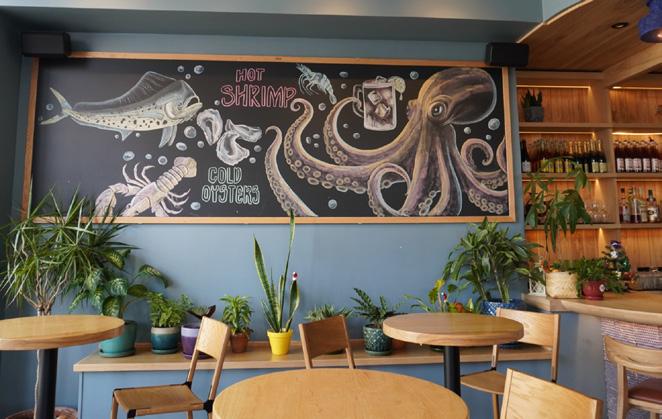
BY KAYLA SCHVARTZMAN
PHOTOS BY SRUTHI KOTLO
GOTHONG

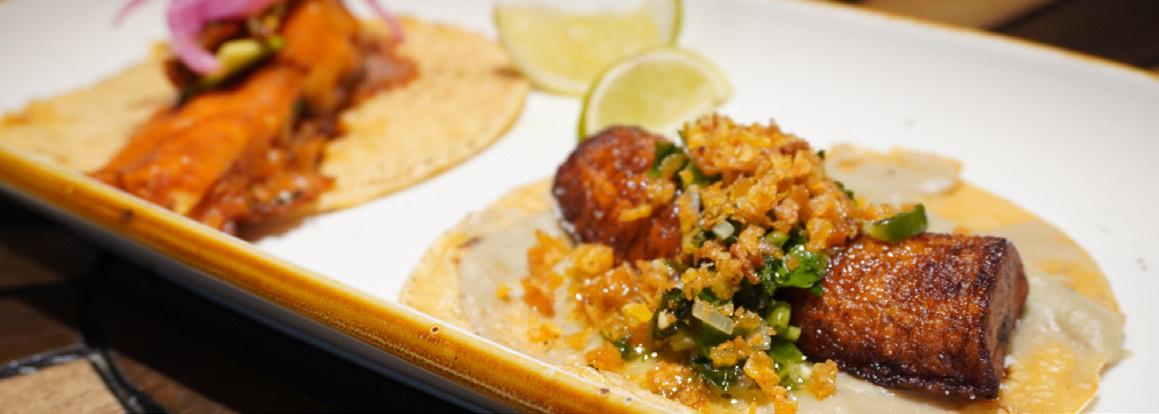
The next contender, the shrimp gobernador taco, had a tough act to follow in terms of flavor. Although it was not nearly as much of an impressive experience as the tuna tostada, it still proved its worth with its usage of unforeseen flavor combos. It featured a soft corn tortilla topped with minced shrimp stuffed inside a crispy cheese shell, a concept which I was unfamiliar with before and was skeptical of before trying. The cheese provided a crunchy contrast to the soft taco and shrimp, and the flavor was slightly pungent, but went quite well with the other flavors. The star of the dish was in the details, with the lime and salsa macha on top contributing heavily to the well-rounded flavor of the taco. This salsa macha—made with a blend of sesame seeds, peanuts, rehydrated peppers, and pepitas—gave the taco texture and a kick,as well as an earthiness that grounded the dish. Overall, I am not as sold on this one as the tuna tostada, but it proved to be a tasty contender using engaging variations in textures which left me curious about all I have yet to try on the menu!
Mariscos San Pedro promises to deliver above all else an innovative yet easy-going dining experience, where the flavors prove complex yet crowd-pleasing.. Dining there is a warm, inviting experience, where quality of ingredients and innovation are made accessible without a hefty price tag. Most importantly, the experience is guided by a very personable wait staff who are willing to walk you through each menu item with care. I definitely recommend it, and if you find yourself in the Pilsen area or maybe have just seen a concert at Thalia Hall, Mariscos San Pedro is a great place to visit for unforgettable flavors.
1 https://www.theinfatuation.com/chicago/reviews/mariscos-sanpedro


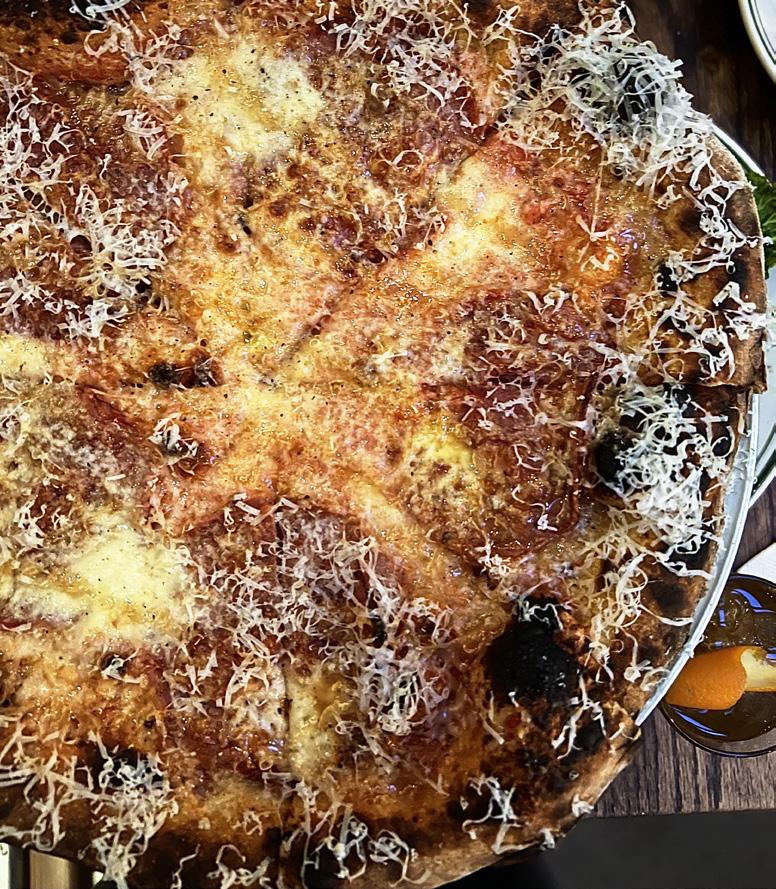
BY IAN HENDERSON
PHOTOS BY ALI ARAGON
When out to dinner, one of the earliest decisions you have to make is what to have to drink. At many establishments, I will stick with my “go-tos”: a diet coke, an inexpensive glass of Italian red wine, or a corona. But then there are situations where my mind drifts away from those trustworthy options. Often, it is due to catchy phrases on the menu or speeches by the waitstaff about how the restaurant serves “local,” “sustainably produced,” “farm to table” wines and beers. I always try to make an active effort, when I can, to support local businesses that have intense competition from larger companies. During my first visit at Bungalow (owned by a sustainably produced brewery/winery based in Michigan called Middle Brow), I waded into the muddy waters of their beer and wine selection. Each wine option had a funky sentence next to its description on the menu. My sister and I landed on “Boats,” a Riesling described as a “Freak Wine for Sharp Tongues.” We both did not know what to expect.
As I took my first sip, I was pleasantly surprised by the crispness and acidity. Moreover, it paired perfectly with our two pizzas: Margherita and Sausage + Olive. The heaviness of the sausage was cut by the brightness of “Boats.” As explained by the maître d’, the flavor profiles of the wines are distinct due to the strategy of their West Michigan farmers. Both French and American grape varietals are brought into the region and grown together which provides a new experience for even well-travelled wine experts. The white wine we picked cut through the heaviness of the sausage. Moreover, the rich tomato sauce was delicately placed throughout the pie and allowed the flavor of the dough and toppings to come forward and complement the wine.
For the rest of the food options, it is clear that the menu is not curated just to advertise their wines and beers. The chef has taken the time to build an impressive menu of appetizers and pizza. “The Big Salad” is a favorite by most guests as the apple cider-based dressing and globs of gouda create a rich and sweet-tart flavor and
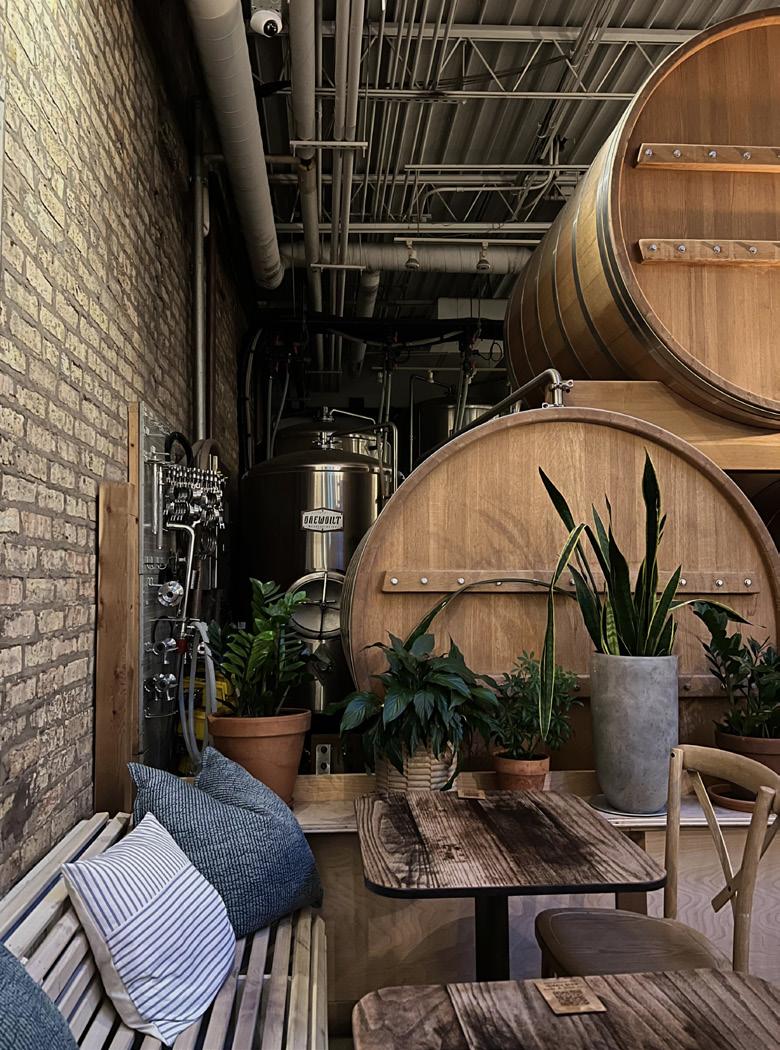
>> NEIGHBORHOOD LOGAN SQUARE
>> PRICES
$$
>> DISHES TO TRY
THE BIG SALAD
MARGHERITA PIZZA
SAUSAGE + OLIVE PIZZA
a great starter to share with their many complementary breads. The pizzas certainly steal the show. The flour is sourced locally as well from the Meadowlark Farm in Wisconsin. As a result, the crust has a strong sourdough flavor, and its airiness is akin to a classic Neapolitan pie. A fan favorite is the potato and leek pizza, which is perfect for a cold winter day and pairs well with some of the heavier wines on the menu. I appreciate that the classic pizzas are available, but their foundations are taken into new directions such as their prosciutto pizza which is topped with earthy mustard greens for a twist.
Stepping into the bright interior of Bungalow with its floral decorations and laid-back staff gives off a casual and relaxing feel. While it is the perfect place for casual dates or group events, the beverage options and food menu elevate the establishment to a truly refined experience. I look forward to returning to see the new catchphrases for wine varieties and pizza formulations and digging into their newest creations.
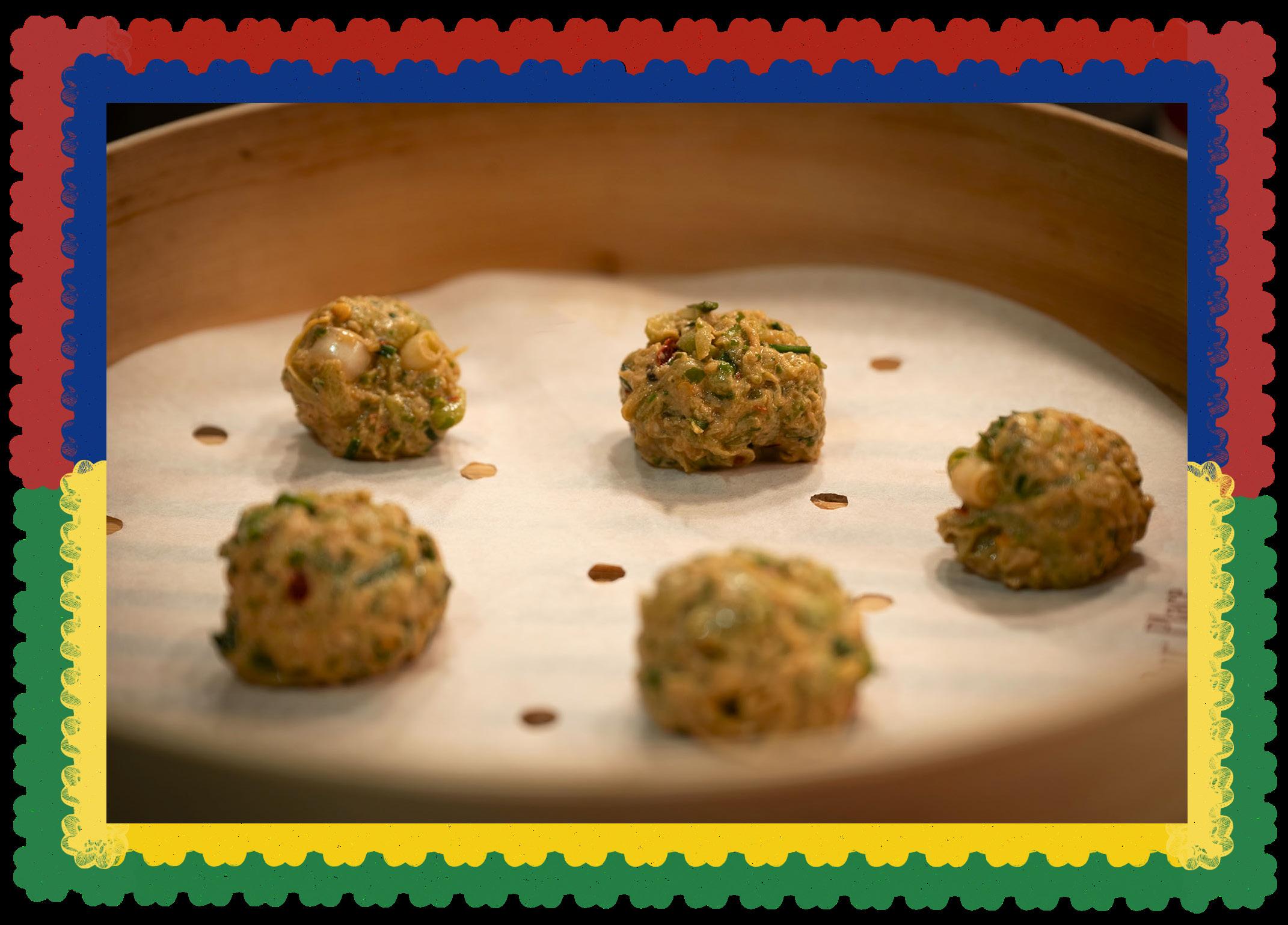
BY KASH BABOOLALL
prep 40 minutes cook 15 minutes makes 8 servings
1 cup grated chayote (strained)
2 tbsp furikake
¼ cup chopped chives
¼ cup chopped scallions
1 tbsp crushed red pepper
2 tsp onion powder
2 tsp garlic powder

Niouk Yen, also known as “boulettes chouchou” (chayote dumplings), are beloved streetfood delicacies from the vibrant cultural melting pot of Mauritius. Mauritian cuisine is a flavorful blend of Indian spices with influence from French and African cooking, enriched by the distinctive techniques of the Sino-Mauritian community.
Chayote, also known as christophine or mirliton, is a green pear-like fruit that belongs to the gourd family. When cooked, chayotes become tender and release their pleasantlysubtle sweet taste. The use of chayote has spread from Mesoamerica to Asian countries and Indian Ocean islands, including Reunion and Mauritius. In Mauritius, chayotes are included in savory dishes such as salads, sautes, dhal/dal and dumplings, as well as sweet dishes like caramelized chayotes and stuffed chayote cakes.
Unlike most dumplings, this dish does not have wrappers and fillings. The dumpling ingredients are simply mixed together, bound using cornstarch, shaped like balls and steamed. The comforting chayote flavour and the enjoyable mochi-like texture come together to create a Mauritian street-food delicacy.
1. Peel and grate the chayote. Toss with salt and let sit for 10 minutes.
2. Strain using a cheesecloth to remove excess water.
3. Mix chayote with furikake, chives, scallions, spices, and vegan oyster sauce.
4. Gradually add cornstarch until the mixture forms a malleable paste.
5. Shape into balls and steam for 15 minutes.
6. Serve hot with soy sauce and chili oil.

BY CONNOR BLOCH

prep 60 minutes
plating 15 minutes
makes 3 servings
GET
½ lb Red Snapper
2 Nectarines (Thinly Sliced) Salt
Small Mint Leaves
1 cup Basil (packed)
1 cup Grapeseed Oil
1 cup Tangerine Juice
2 Limes
3 tbsp Miso Paste
2 tbsp Light Soy Sauce
1 tbsp Dark Soy Sauce
1 tbsp Mirin
2 tsp Water
2 tsp Cornstarch
¼ cup Olive Oil
While not complex regarding ingredients or preparation, the simplicity of this dish allows the cook’s experience to shine through. Skillful knife cuts on the fish, nectarines, and proper sauce technique are integral to a successful plate. This dish is inspired by the bright flavors of summer, with fresh fruit and herbs to cut through a bright, acidic sauce. Mastery of one’s flavor preferences is vital for developing this recipe, as edits to the sauce’s final flavor should be made to align with your palate. Picking a fish with lower levels of connective tissue is integral to this dish’s success, as it is served raw. After eating the fish and nectarine slices, this dish should be eaten with a spoon to enjoy the rest of the tangerine sauce with basil oil. Enjoy!
DO
Basil Oil
1. Wash and thoroughly dry basil leaves.
2. Heat grapeseed oil to 350ºF.
3. In a blender, pour the hot oil over the basil leaves and blend on high until thoroughly combined.
4. Pour mixture into a mason jar and let cool in the fridge overnight
5. The next day, strain through cheesecloth (or a super fine mesh sieve) to remove all basil pieces.
6. Store in a squeeze bottle for easier distribution.
Tangerine Sauce
1. Pour tangerine juice, lime juice, miso paste, light & dark soy sauce, and mirin into a blender and blend on high until combined.
2. Taste and adjust to preferences.
3. Mix the water and cornstarch in a separate bowl.
4. Slowly pour the cornstarch slurry mixture into the sauce while the blender is running, adding a little bit at a time until the desired thickness.
5. Pour the olive oil into the tangerine mixture to emulsify, going slowly so as not to split the sauce.
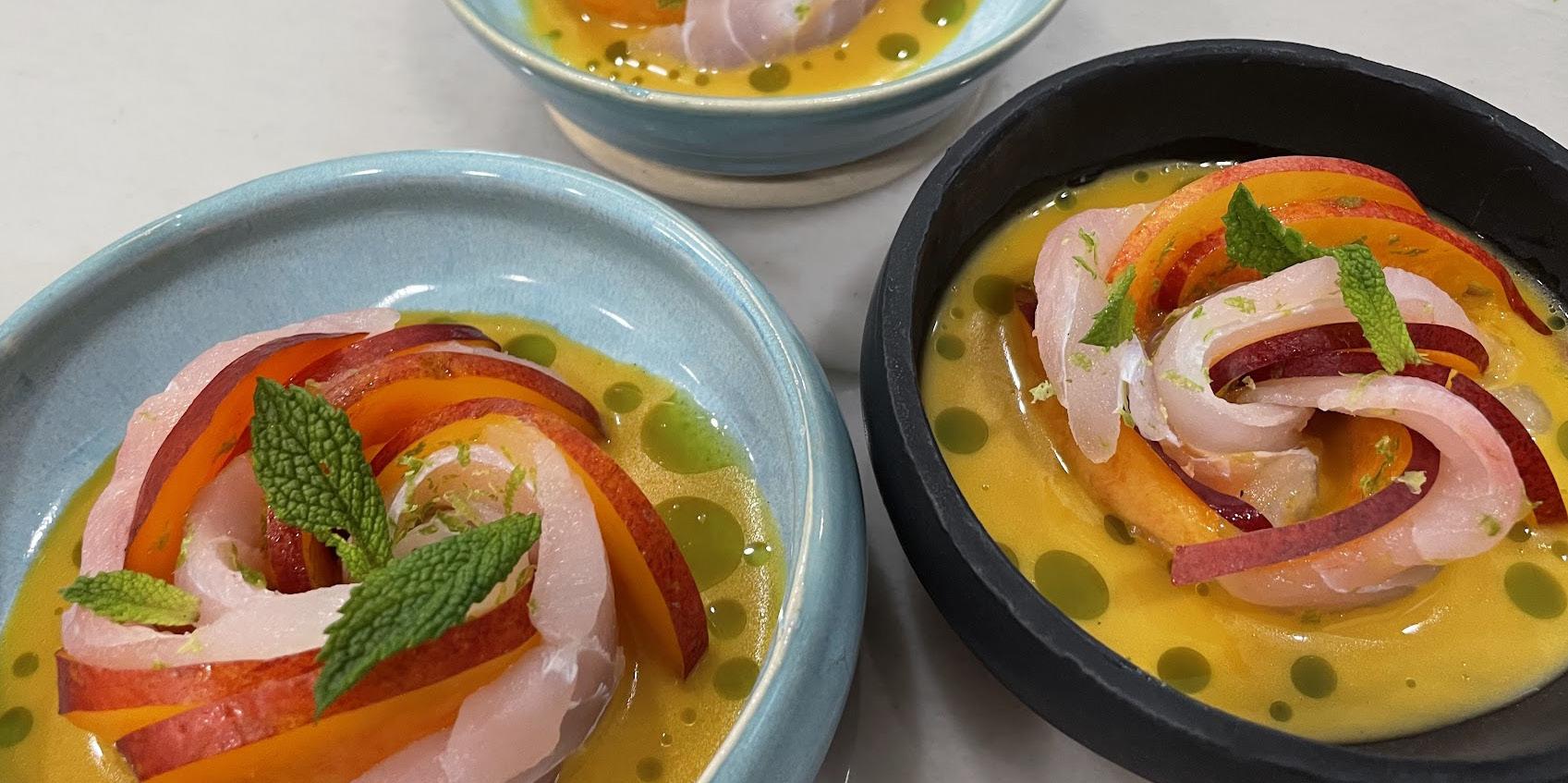
1. Get a uniformly pieced block of snapper and slice at an angle, making wide and thin slices.
2. Cut your nectarine in half and gently twist to remove the pit, then twist (or cut if necessary) the pit out of the other half and slice thinly.
3. Layer one slice of fish then two slices of nectarines lengthwise with a slight overlap.
4. Once there are 3-4 pieces of fish in the line, season the top side with salt and lime zest.
5. Roll the line up into a pinwheel, resembling a rose.
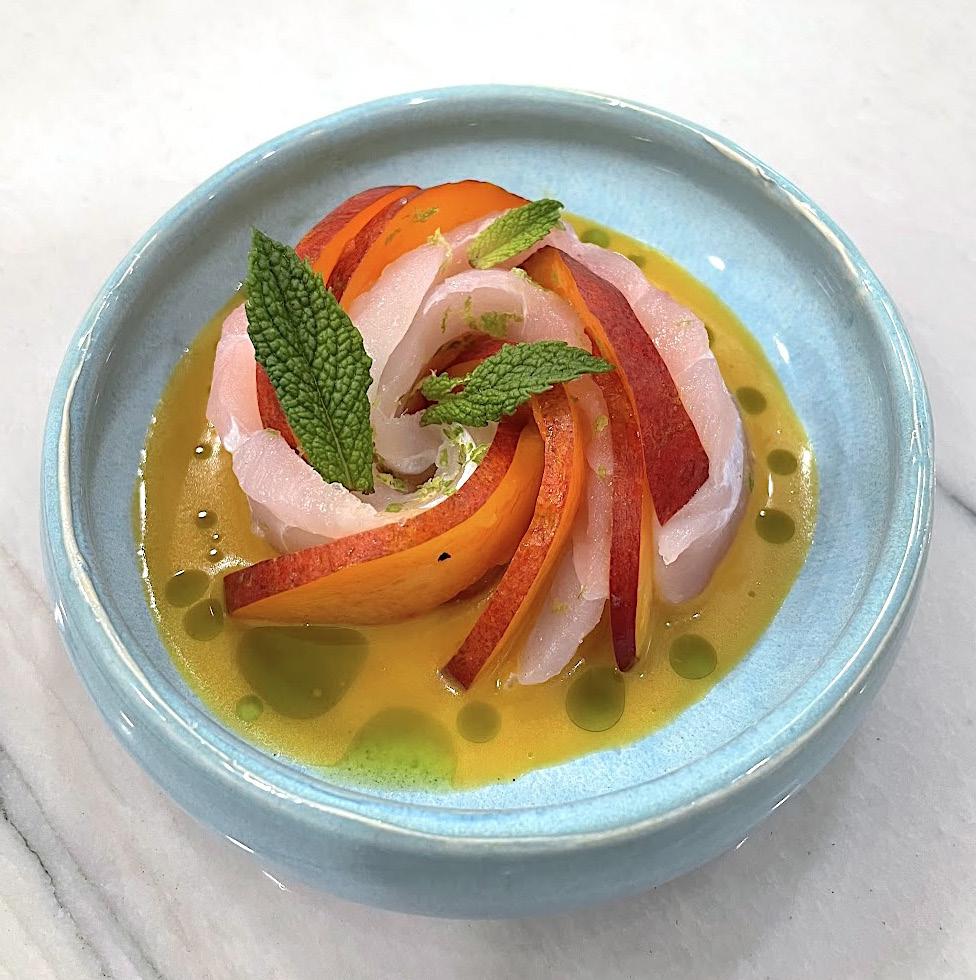
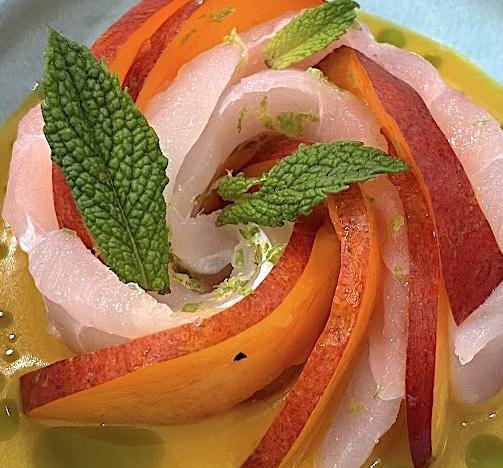
1. Pour 2 tablespoons of your tangerine sauce down in a small bowl.
2. Lay the Snapper and nectarine rose in the middle of the sauce.
3. Dot basil oil on the tangerine sauce around the fish.
4. Top with 3 small leaves of mint.
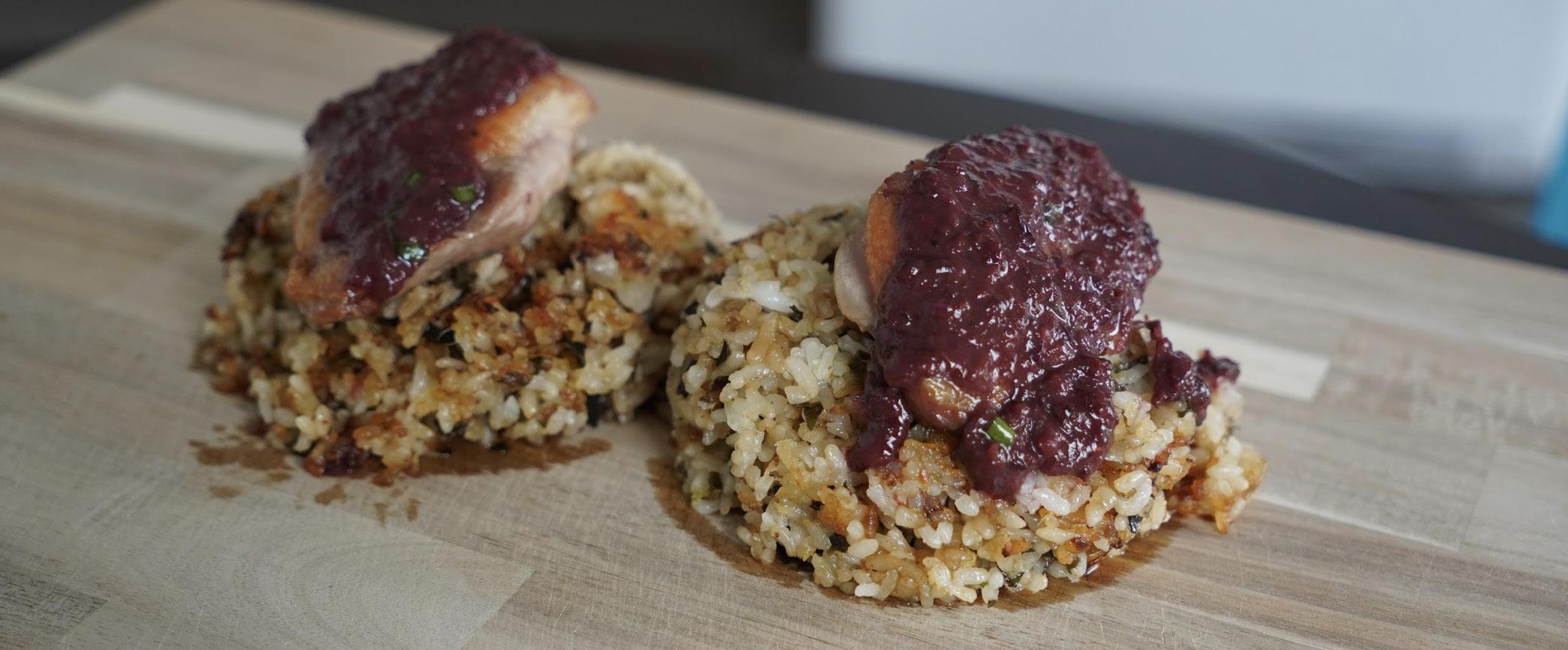
BY KAI SCHIRMACHER
PHOTOS BY JONATHAN JI
prep 1 ½ hours (spread over 1-2 days)
cook active: 30 minutes passive: 4-8 hours makes 2 servings

GET
For Duck & Sauce
1 headless duck
1/4 lb pitted sweet cherries (frozen or unfrozen)
1 small shallot
2 cloves of garlic
1 in knob of ginger
2 tbsp butter
1/4 cup red wine
1/4 cup duck stock
salt & pepper
(to taste)
For Tea Fried Rice
1 cup cooked rice (left in fridge overnight)
soy souce green tea (enough to make one cup)
2 in knob of ginger
5 medium cloves of garlic
3-4 scallions
2 eggs
salt & pepper (to taste)
Duck is criminally under-appreciated in the home kitchen. At the best of times, it isn’t easy to find in a restaurant, and finding it in a grocery store can be an absolute struggle—88 Marketplace is my go-to duck buying market in Chicago; additionally to butcher a whole duck my preferred instructions/video is by “How To Break Down (butcher) a Whole Duck” by Jacob Burton on YouTube.1 Fortunately for us home cooks, this rarity makes it all the more impressive when we serve it. If you’re looking to make a statement at your next event, this is the recipe to serve: rich pan-seared duck pairs beautifully with a rich and savory cherry sauce, plated over a wonderfully fragrant tea-fried rice. Inspired by the summers I spent visiting my grandmother’s home in Taiwan, the flavors and aromas of the dish bring me back to the night markets, restaurants, and tea shops of Taiwan, where the smell of tea permeates the air and all the best food in the world is right in front of you. The richness of the duck pairs perfectly with the silky cherry sauce and is rounded out with the tea fried rice. This recipe is bound to be the centerpiece of your next event, and I promise the meal will be talked about long after you and your friends finish eating.

Duck and Sauce
1. Butcher your duck, separating the carcass, wings, breasts and legs.
2. Oil, salt, and pepper the carcass and wings before roasting in a 425 degree oven until deeply golden brown.
3. Place the carcass and wings into a stock pot before covering with water.
4. Bring the water up to a boil then reduce to a simmer.
5. Simmer duck stock for 4 hours minimum or up to 8 for maximum flavor.
6. Prep the duck breasts by salting before leaving in the fridge for 20 minutes (if butchering ahead of time, the breasts can be left in the fridge for a few days before making the recipe).
7. Finely dice garlic, ginger, and shallots, and cut the scallions into thin circular cuts, separating the scallion whites and greens.
8. Place the breasts fat side down in a cold pan, then bring pan up to medium low.
9. Render the duck breasts until all the fat is rendered out and the side is golden brown, then flip the breasts and cook til medium rare ~140 internal temperature.
10. Remove the duck from the pan and keep warm in the oven - set the oven to its lowest temperature.
11. In the same pan, add ginger, garlic, shallots, and scallion whites and fry till fragrant.
12. Deglaze with red wine, scraping all the fond off the bottom.
13. Add cherries and duck stock and reduce sauce until thickened.
14. Optionally (but heavily recommended), blend the sauce until smooth, then return to the heat and thicken until the sauce covers the back of a spoon.
Tea Fried Rice
1. Make a cup of tea, removing the tea leaves when steeped.
2. Finely dice ginger, garlic, scallion (separating whites and greens), shallots, and the tea leaves.
3. Crack two eggs into a separate bowl and whisk thoroughly.
4. Heat a pan (or ideally a wok) with a neutral cooking oil.
5. Fry ginger, garlic, scallion whites, shallots, and tea leaves til softened and fragrant.
6. Add day old rice to the pan, breaking it up.
7. Once rice is incorporated and cooking, push everything in the pan to one side, add more oil on the empty half and add the eggs.
8. Scramble the eggs until soft, then incorporate with the rice and vegetables.
9. Add soy sauce to taste and finish cooking.
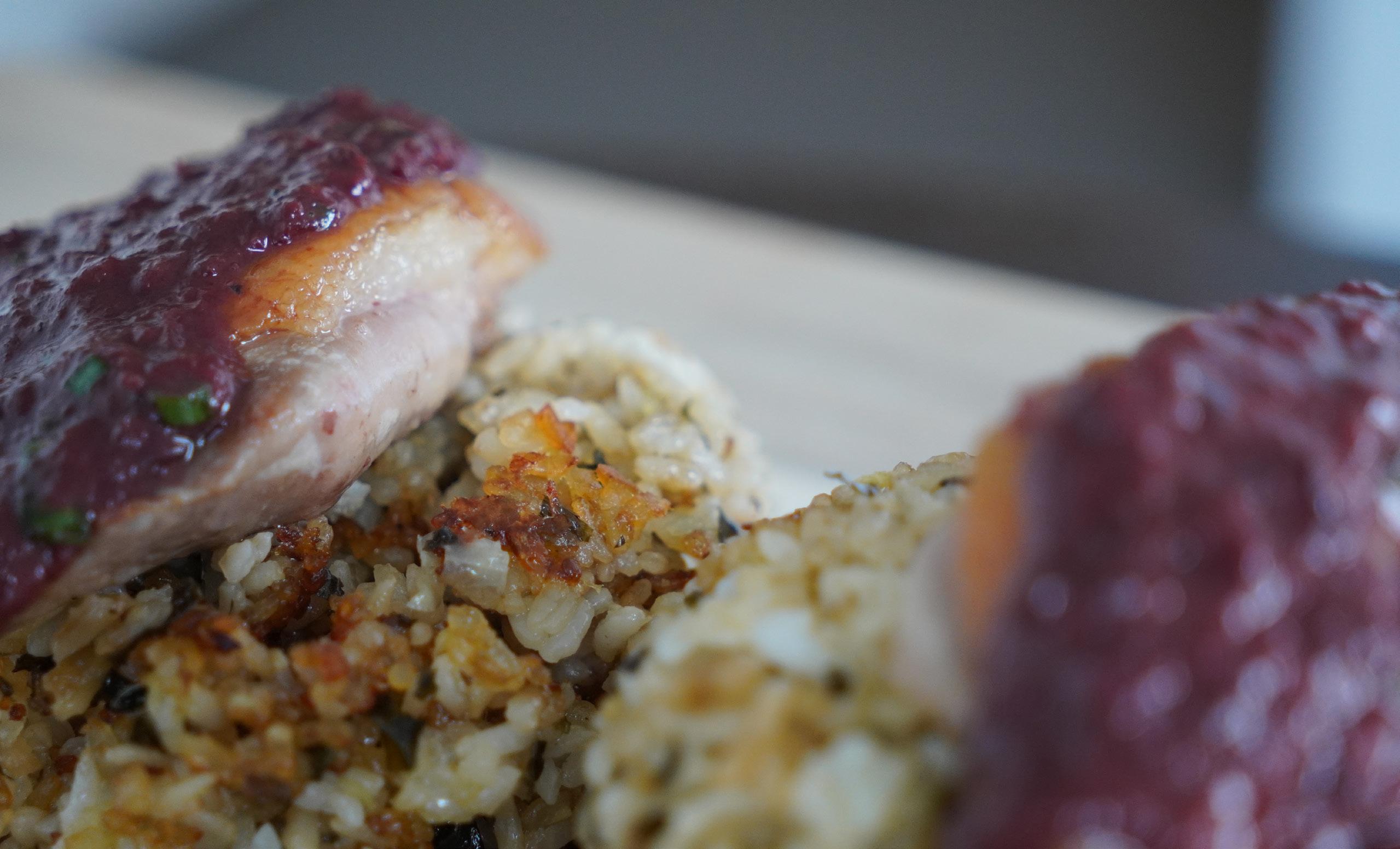
Assembly
1. Tightly pack an lightly oiled bowl with the fried rice, then place upside down on a plate.
2. Cut the duck breast horizontal and place neatly next to the rice.
3. Pour sauce directly over duck.
4. Serve and enjoy!
1 https://www.youtube.com/watch?v=-CS7B9NekMs
prep 20 minutes
cook 35 minutes makes 8-10 servings

BY AUBREY BARB
KOTLO
Corn Bread
2 eggs
¼ cup brown sugar
½ cup greek yogurt
½ cup milk or water
1 heaping cup all purpose flour
1 cup cornmeal
2 tsp baking powder
½ tsp salt
½ cup butter, cubed, room temp
Honey Butter
½ cup butter, room temp
2 tbsp honey
Decoration confetti sprinkles


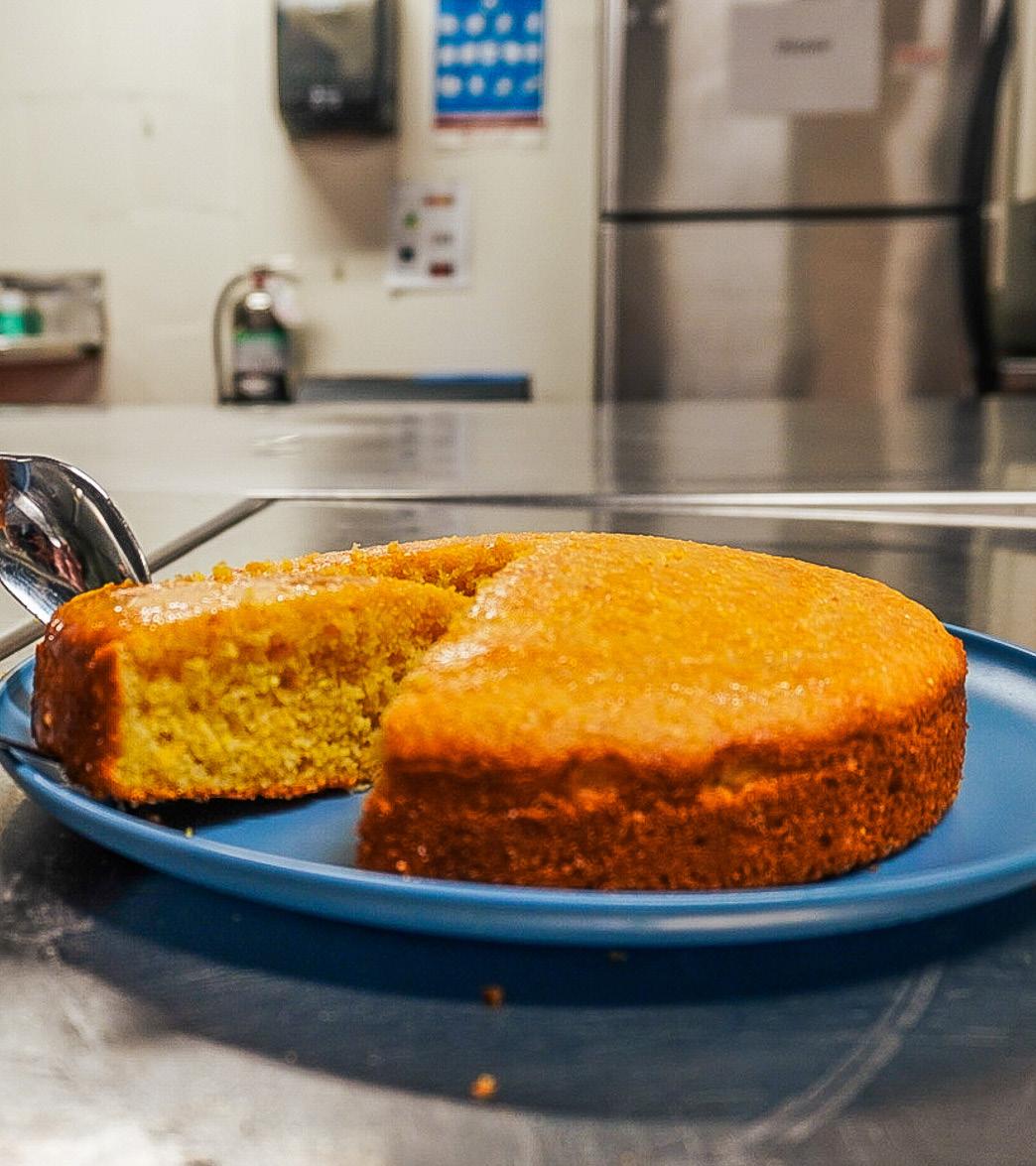
Birthdays in college have a tendency to be depressing, due in part to a nasty workload and a conspicuous lack of birthday cake. The food problem, at least, can be solved. For a new age of birthdays, I offer this recipe, and a proposal for “birthday cornbread”. It’s a discovery I stumbled upon with friends in my first year, and feel obligated to share. Birthday cornbread demands less effort and ingredients than a traditional birthday cake, making it more agreeable with oft-raided dorm kitchens or grocery budgets. However, I can promise that it’s equally high reward. Recommended: make with friends, and eat straight out of the oven.
1. Preheat the oven to 350°F. Grease an 8 inch round cake pan. Tip: after adding the butter in step 4, use the wrapper to grease the pan
2. In a small bowl, whisk together the eggs and sugar. Add the yogurt and milk or water, and mix until smooth.

3. In a larger bowl, whisk together the flour, cornmeal, salt, and baking powder.
4. Add the cubed butter to the dry ingredients, working it in completely with a fork (or fingers) until the mixture has the texture of moist sand.
5. Add the wet ingredients all in one portion, mixing with a spatula until the batter is homogenous. Note: for confetti cornbread, lightly mix ~¼ cup sprinkles into the batter here!
6. Transfer the batter into the pan, and bake at 350°F for 35 minutes. Before taking the cornbread out of the oven, poke with a knife or toothpick and make sure it comes out clean.
7. For the honey butter, whisk the butter with an electric mixer or by hand until soft. Add honey, and mix further until light and fluff.
8. Devour! After the cornbread has cooled for a few minutes, plate and serve with the honey butter, sprinkles, candles, and a song.


About: My favorite food is the grilled peach with goat cheese from the Minnesota State Fair, and my favorite recipe to make is Stroopwafels. After college, I plan to attend culinary school!

I love Indian food, and my favorite recipe to make is brown butter chocolate chip cookies. After UChicago, I plan to take a gap year to do research then apply to PhD programs.


Emily Son
Creative Director
Second-Year, Business Economics and Psychology
About: My favorite food is (homemade) galbi-jjim (갈비찜, Korean braised beef short ribs). I also love baking small bites like lemon madeleines to pair with coffee.

Kaia Griggs
Creative Director
Fourth-Year, Economics
About: My favorite food is Tang Cu Pai Gu, AKA sweet and sour pork ribs, especially the ones my mom makes. I love making different types of Thai curry and love to bake (carrot or cheesecake recipes are my favorite).




Aidan Cessor Programming Director
Fourth-Year, Philosophy
About: I love to explore Chicago’s vibrant food scene. My favorite food is birria tacos, and I love making goulash. Postgrad, I want to do volunteer work with AmeriCorps.
Olivia Shanler
Executive Blog Editor
Third-Year, Psychology
About: My all-time favorite food is a lobster roll from Erica’s Seafood in Maine. I love to bake and my favorite recipe to make recently has been dark chocolate tahini brownies.
Oliwia
Mikos
Head Social Media Manager
Second-Year, Business Economics
About: My favorite food is thick chocolate chip cookies. I also love to make my own dessert recipes that are holiday themed. If you can’t tell already, I LOVE sweets!


Ian Henderson
Director of Finance
Fourth-Year, Biology and Business Economics
About: My favorite food is shakshuka and my favorite beverage is coffee with milk of course. I am working in investment banking after graduation and I hope to own a restaurant in the far future!


